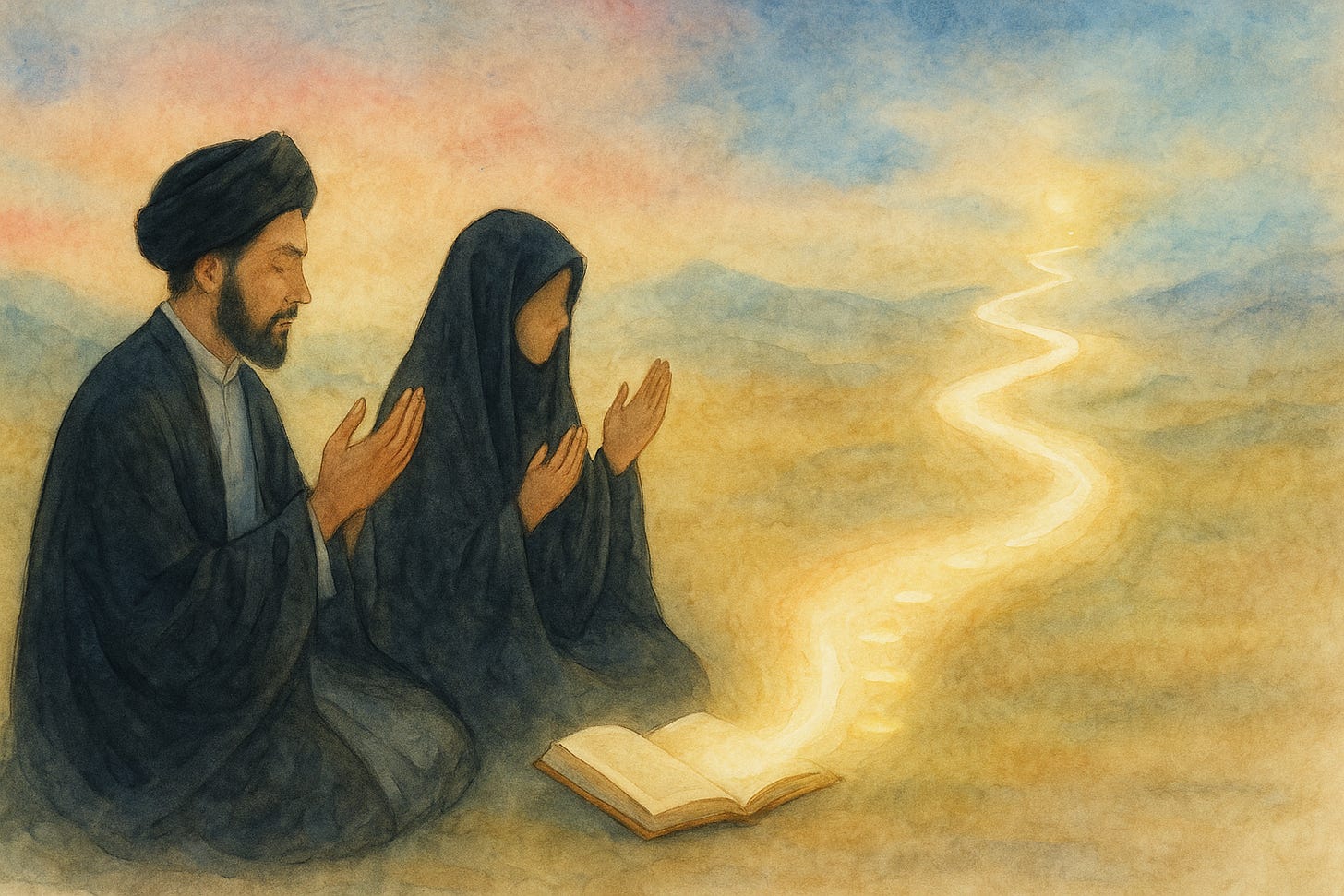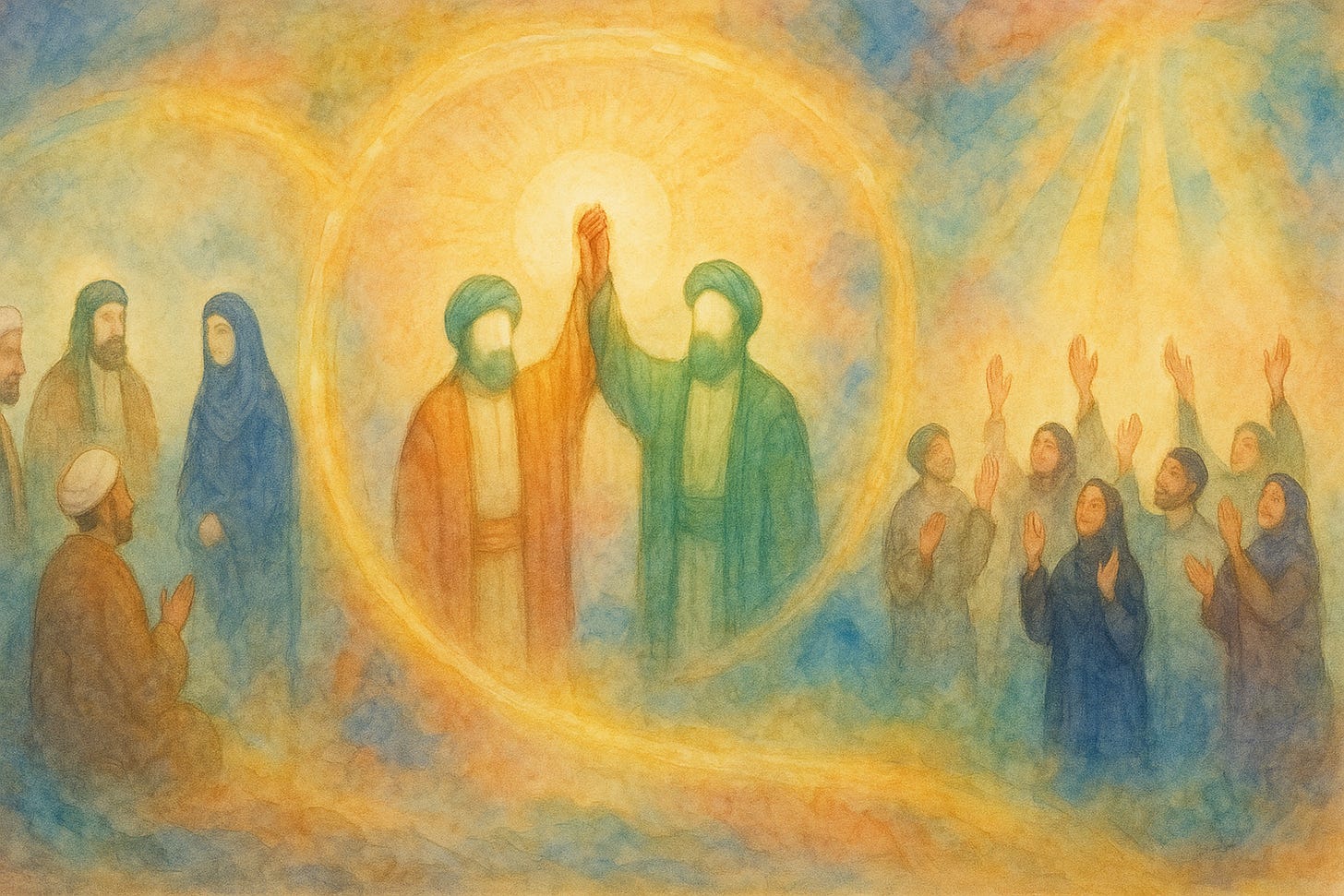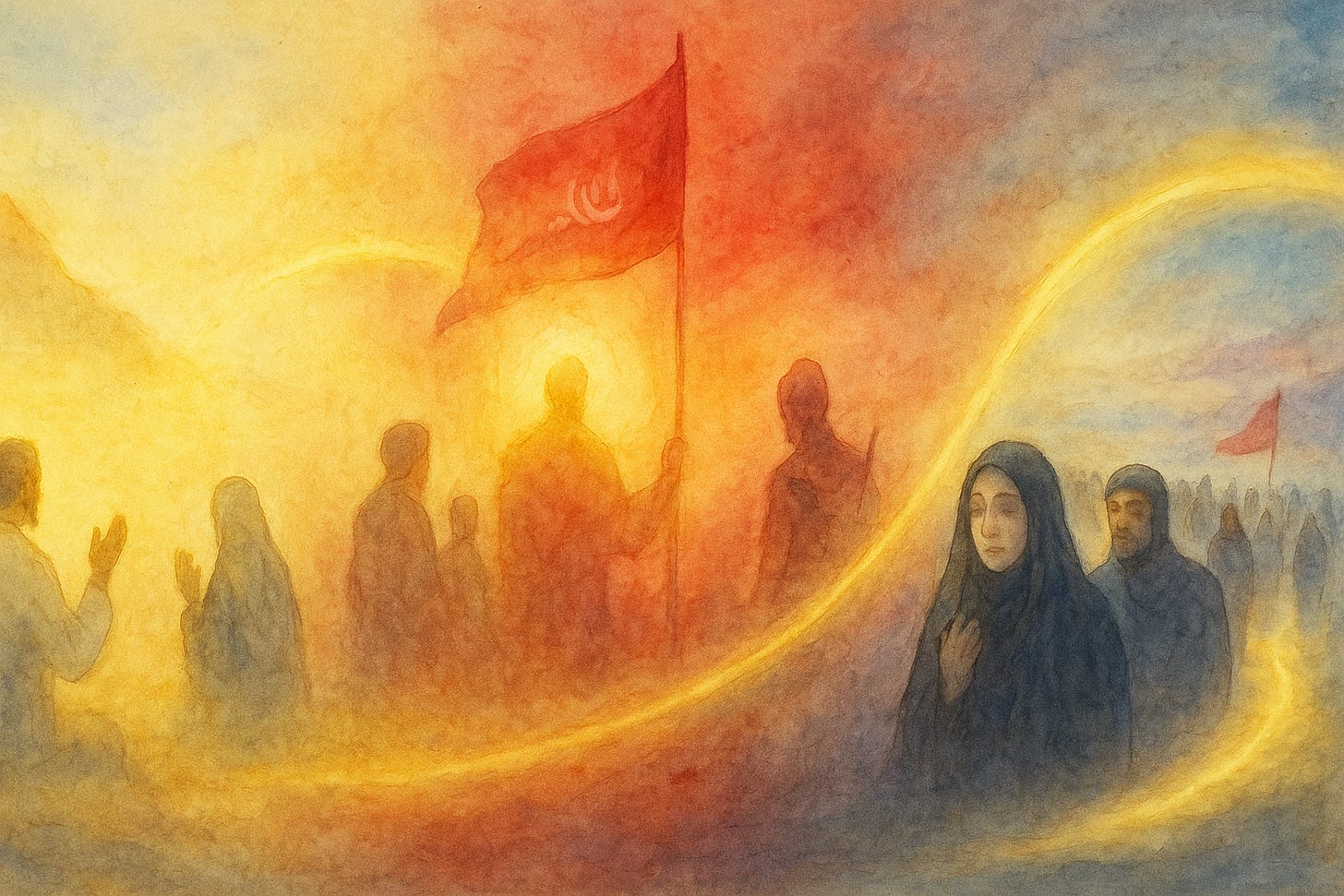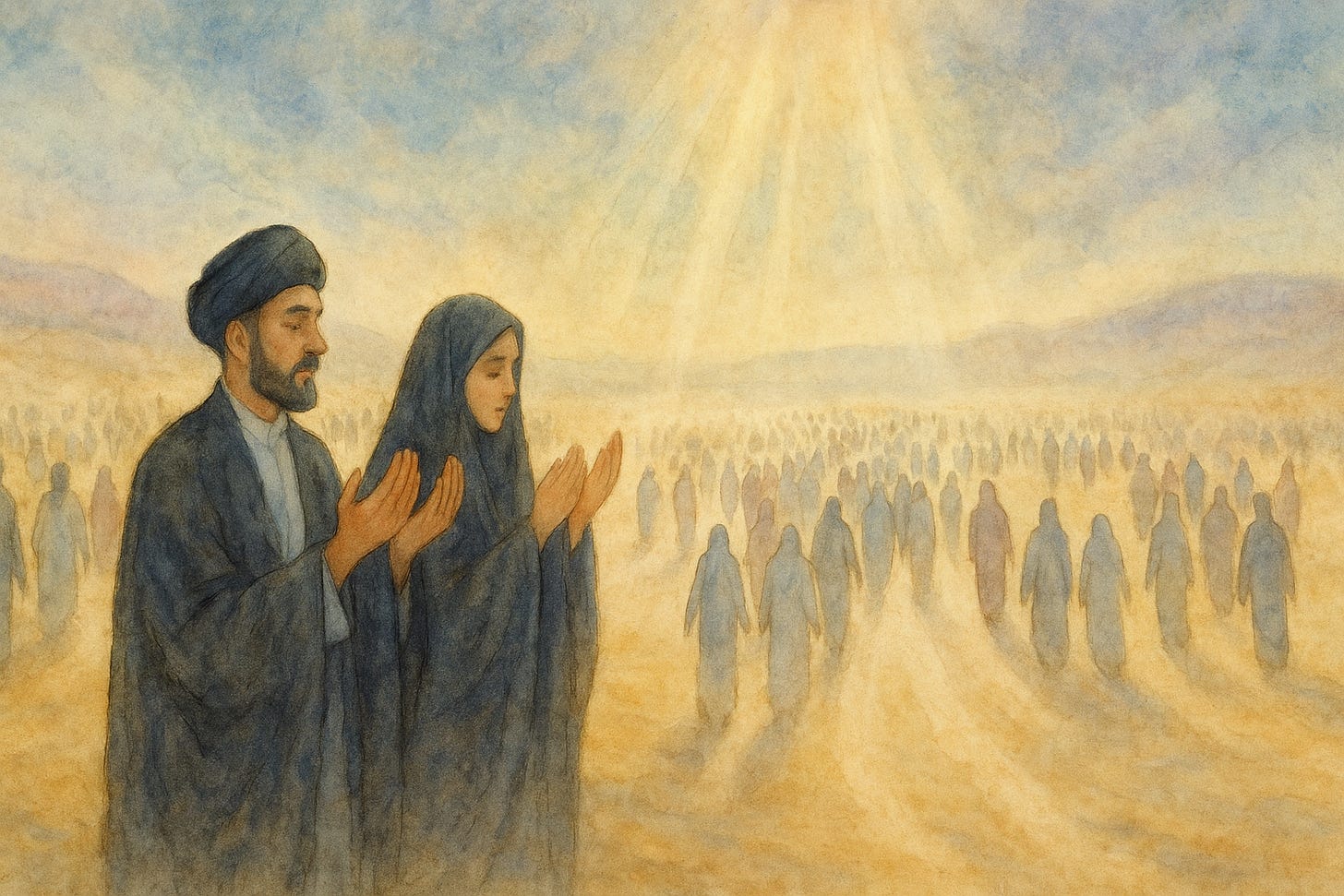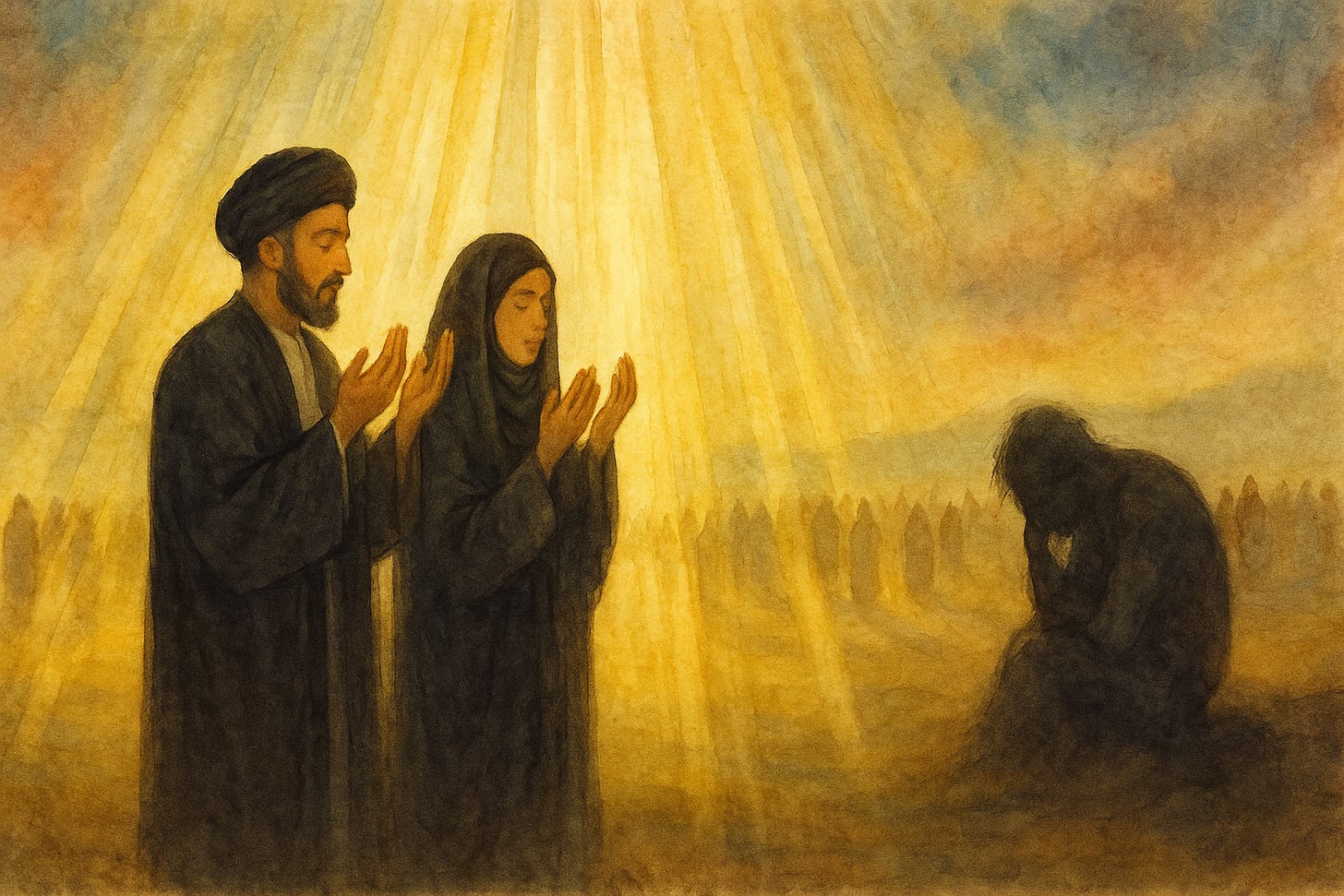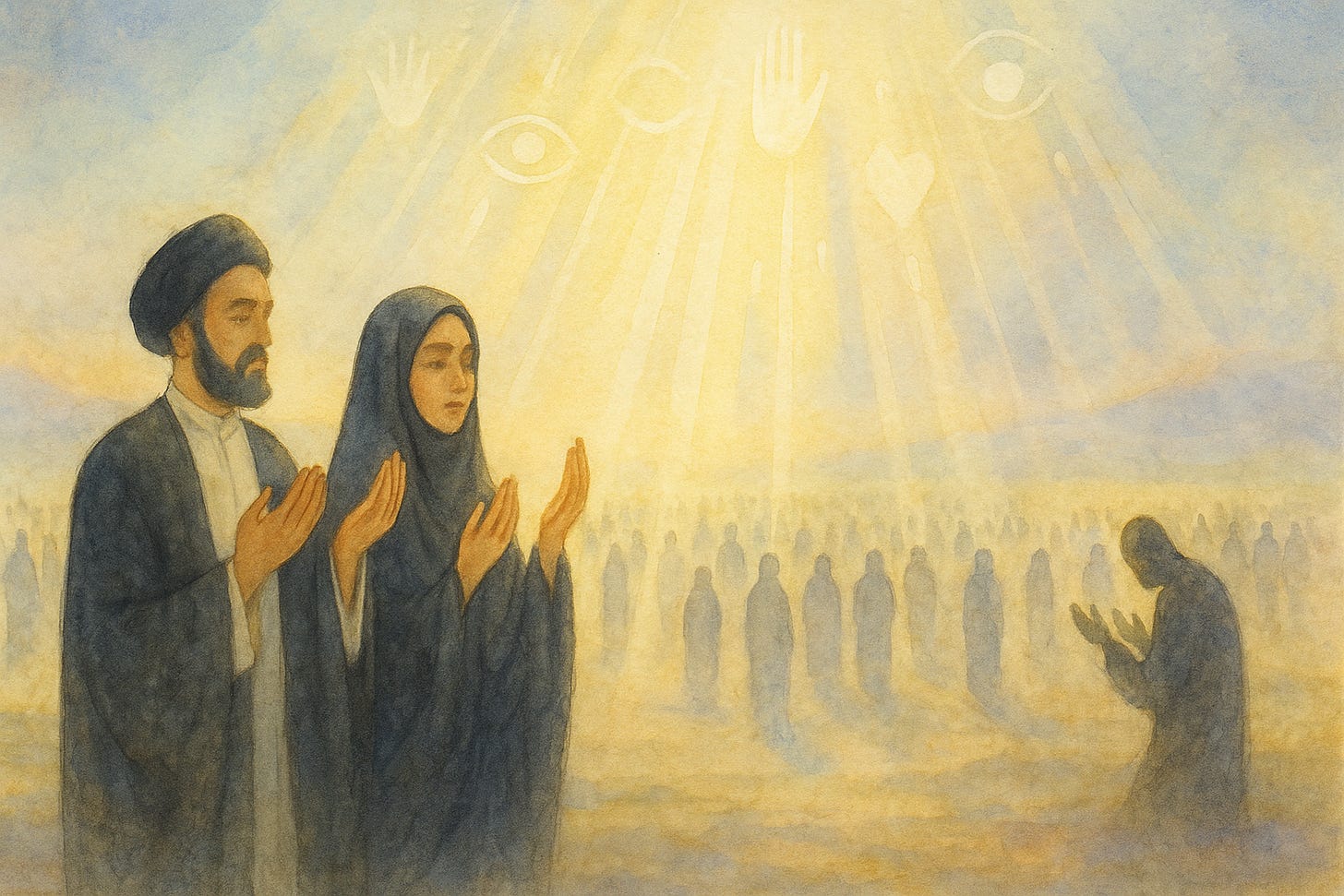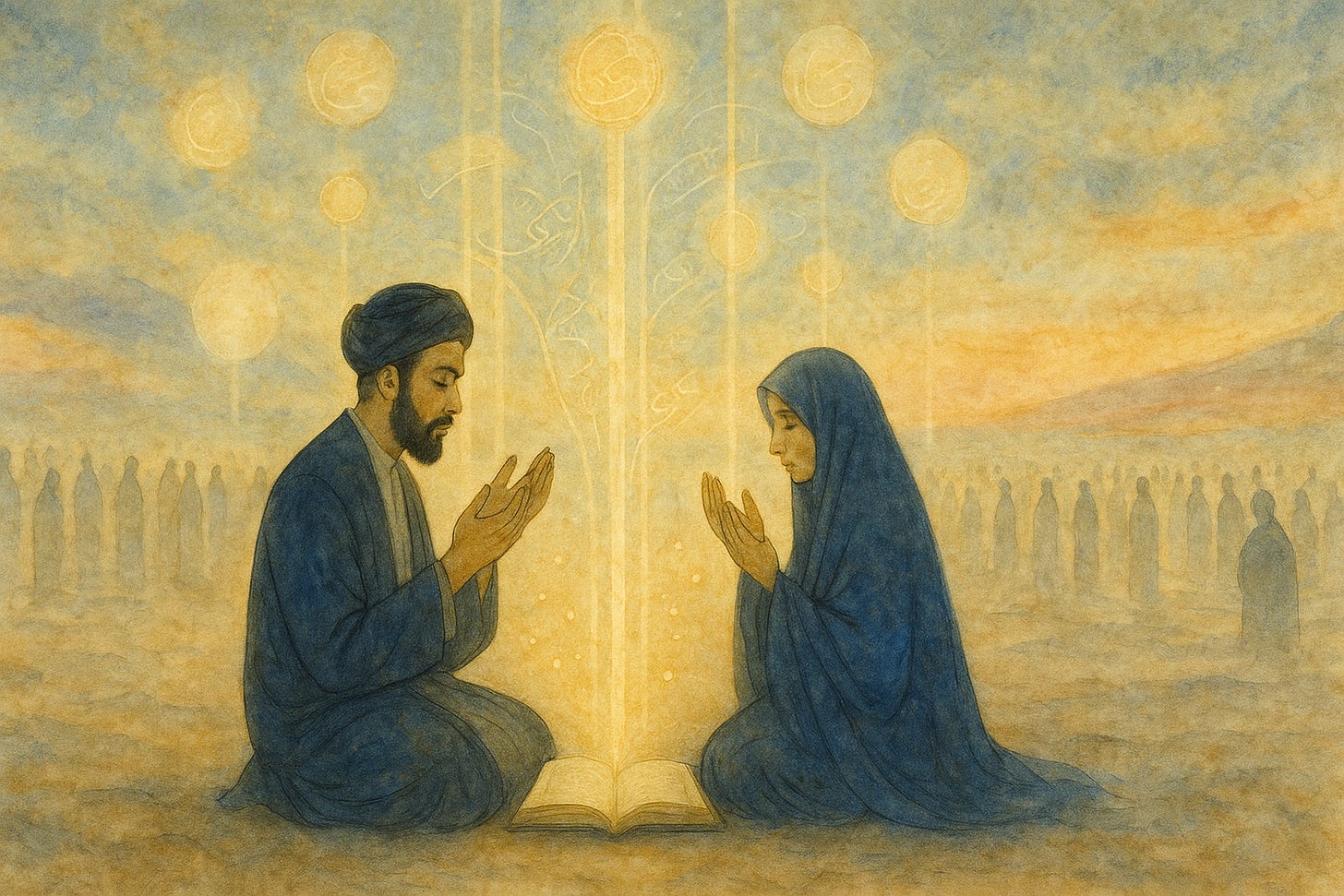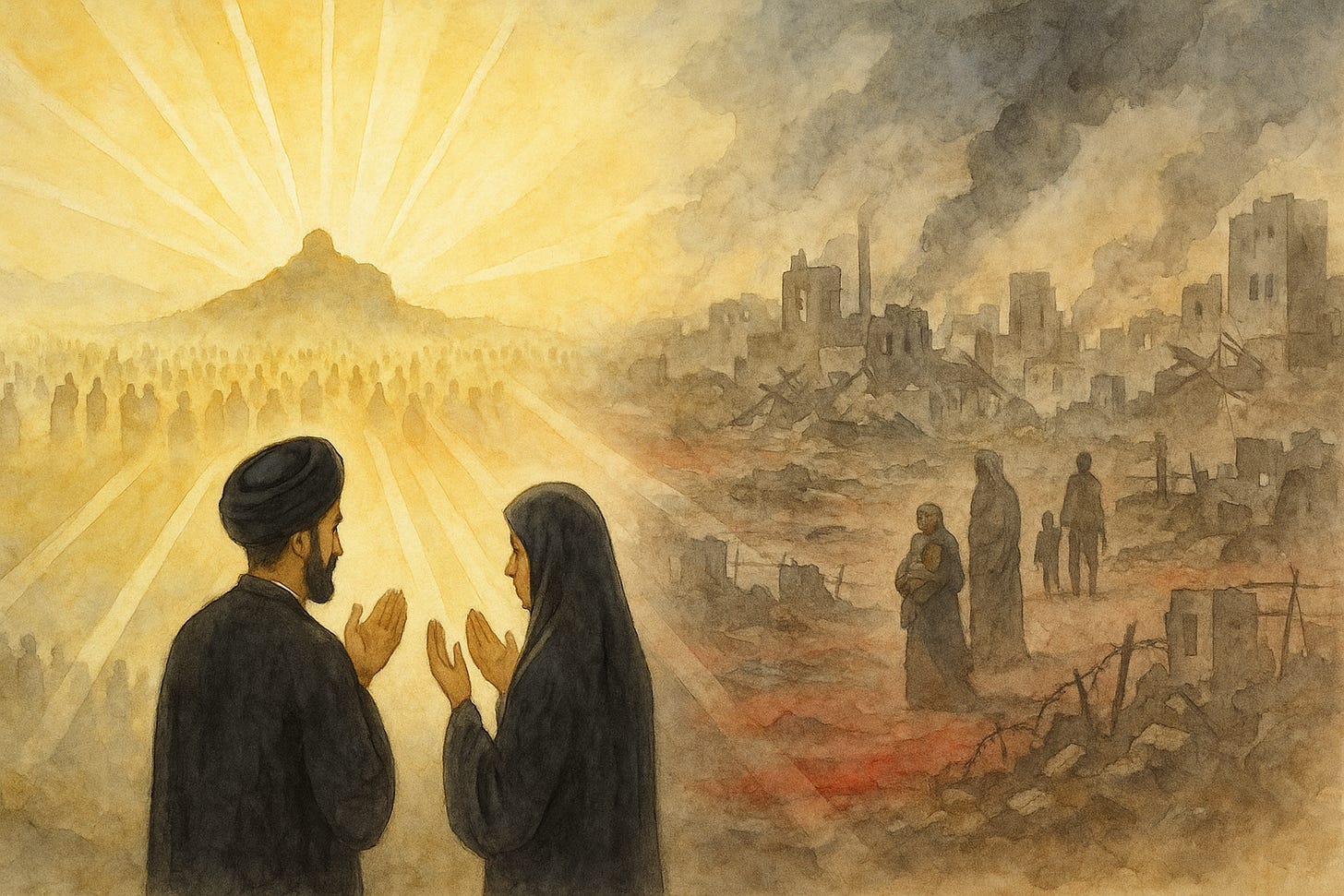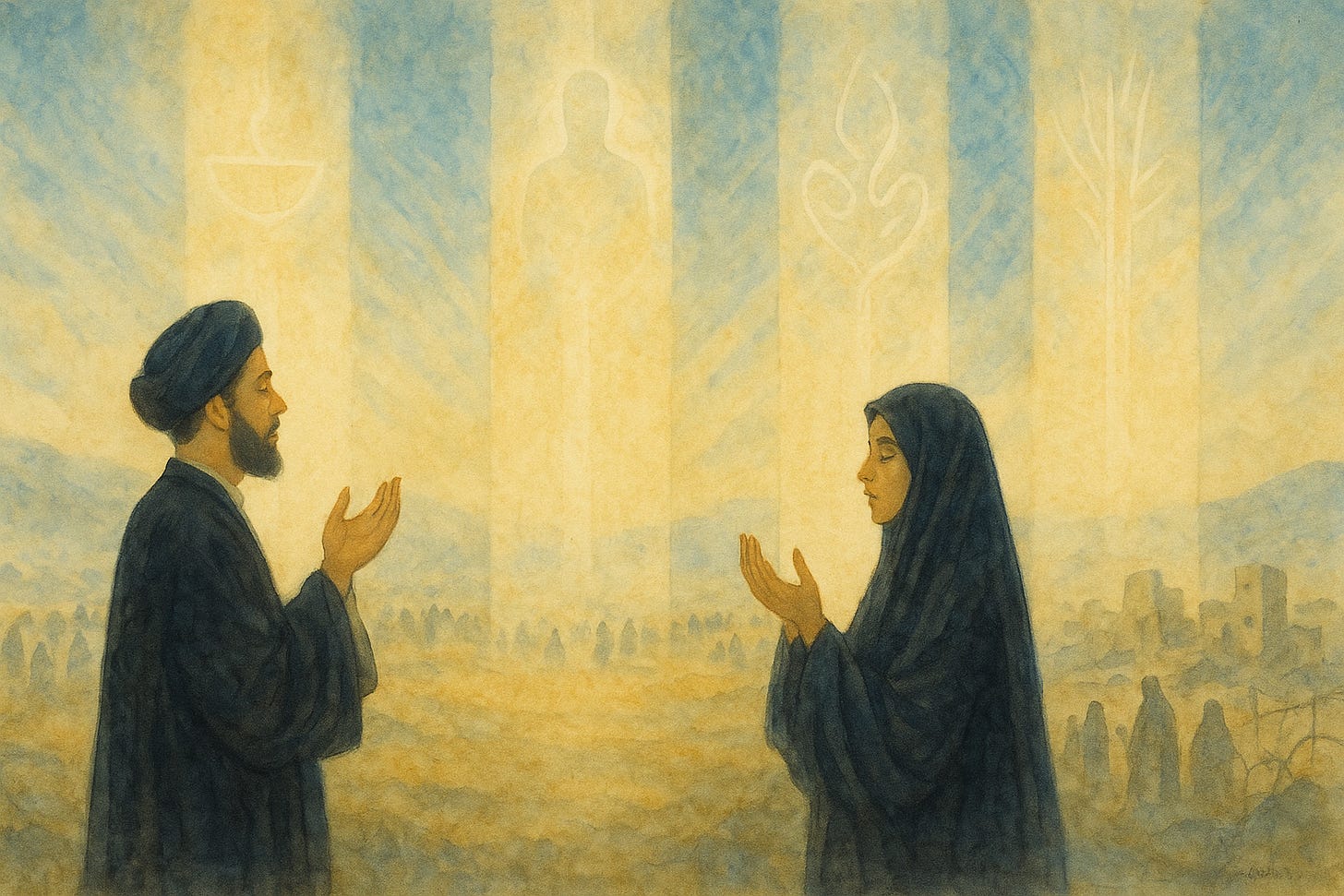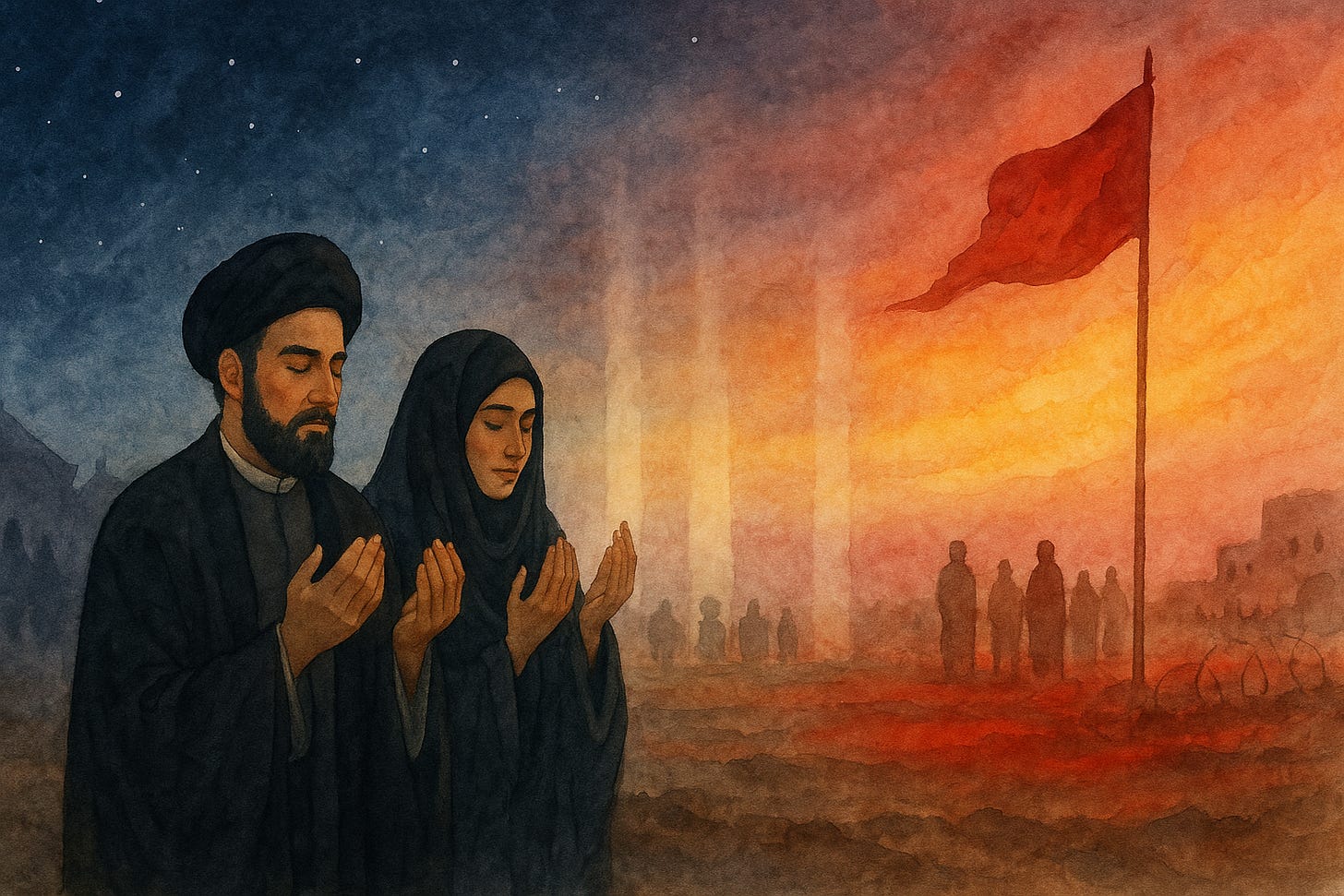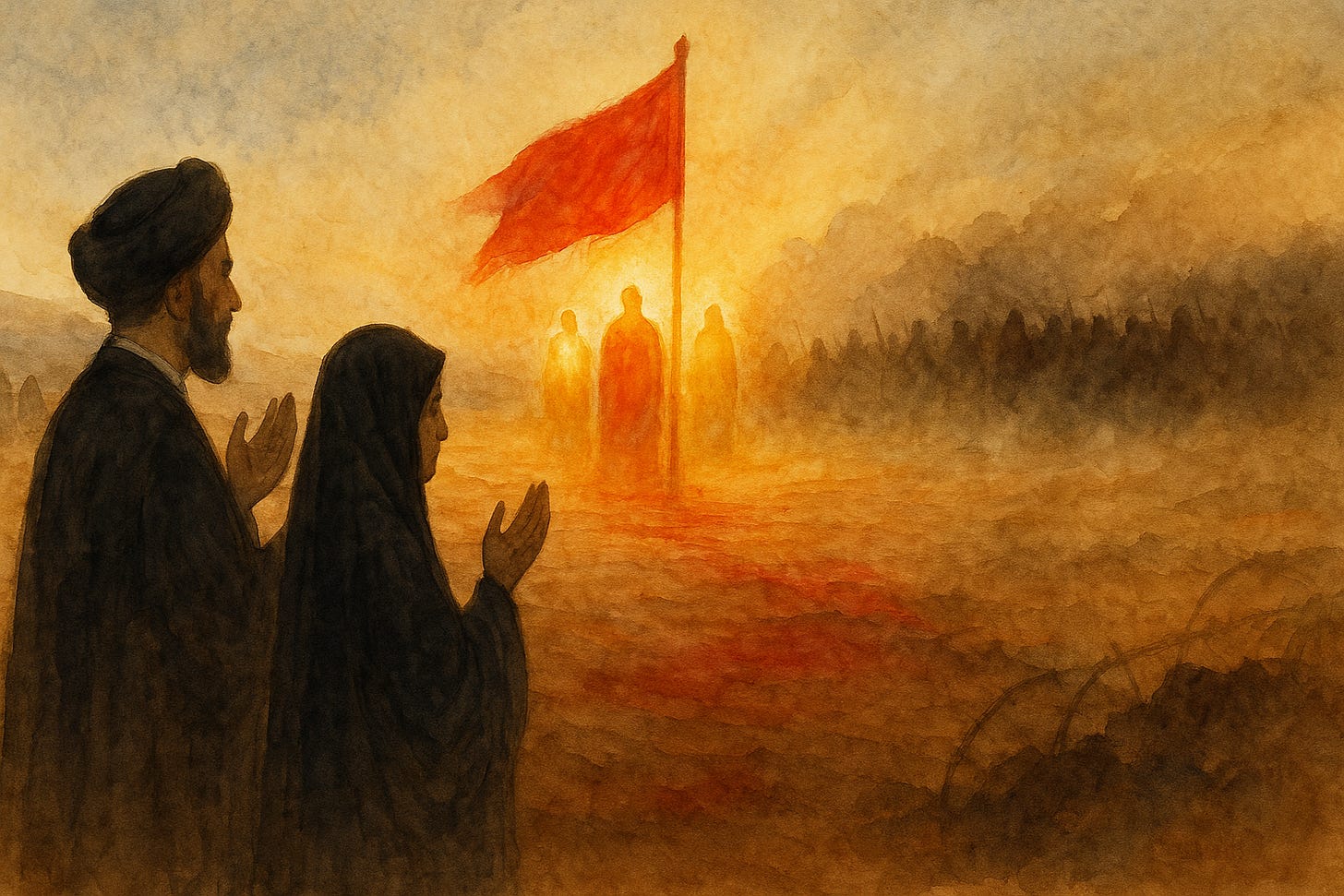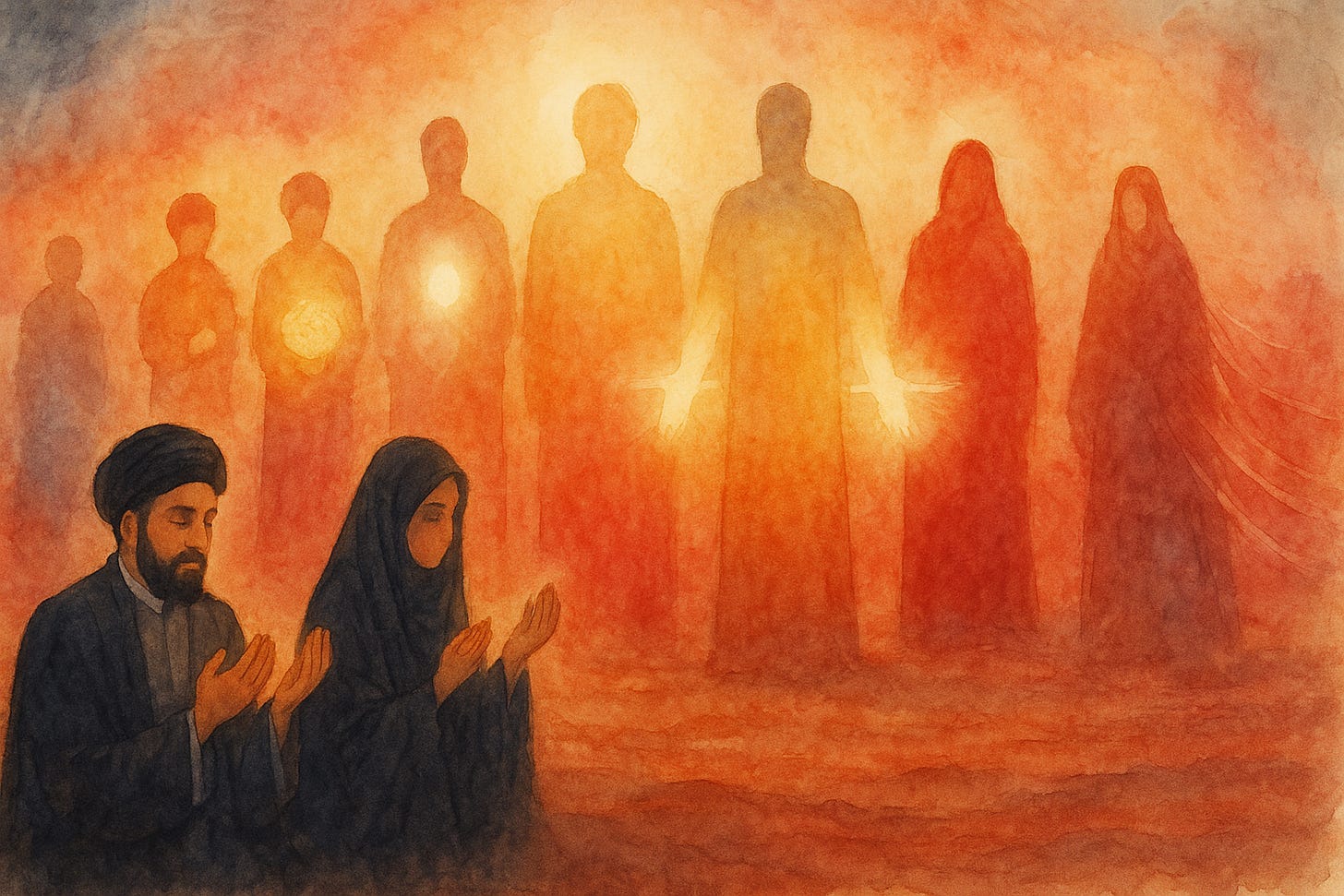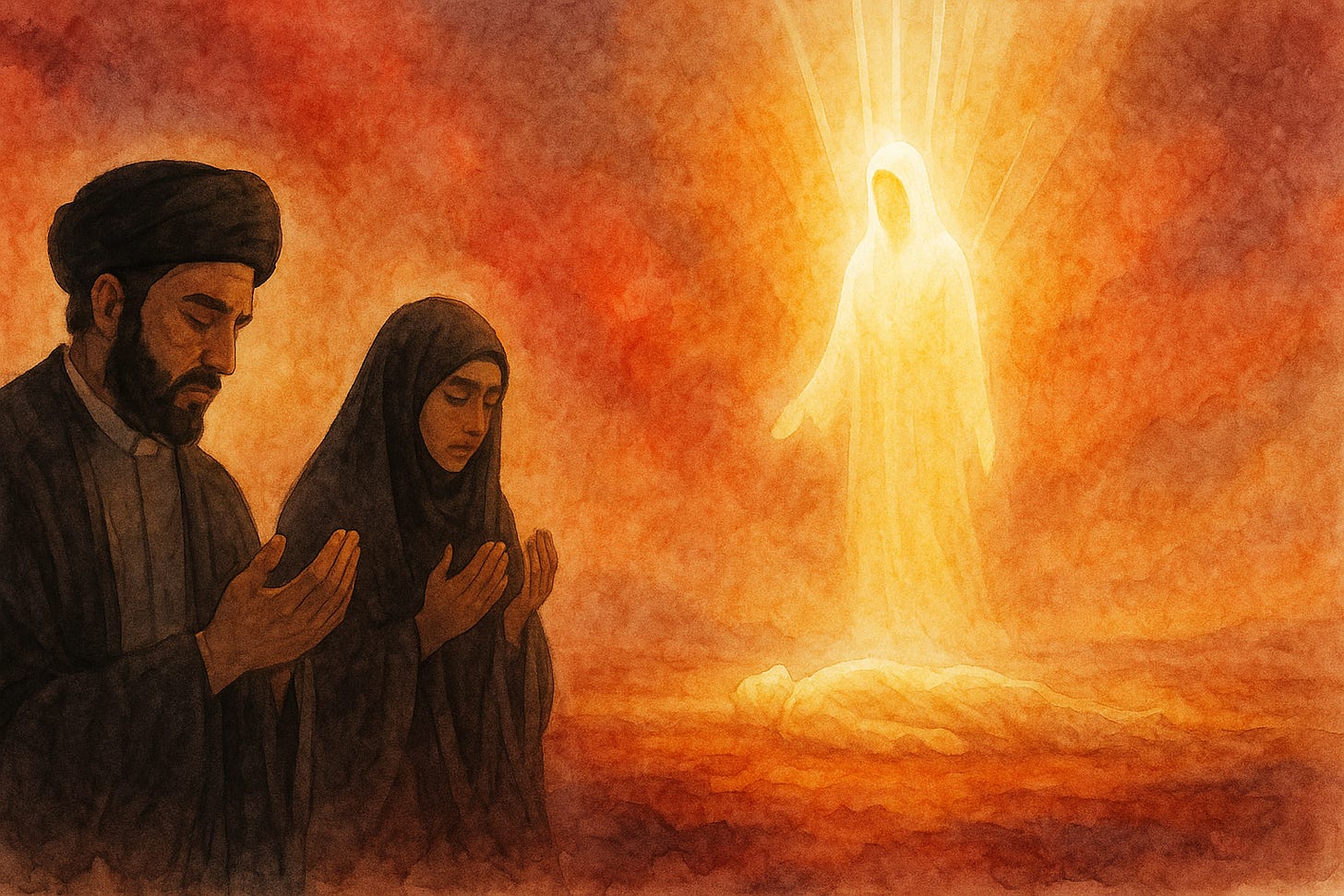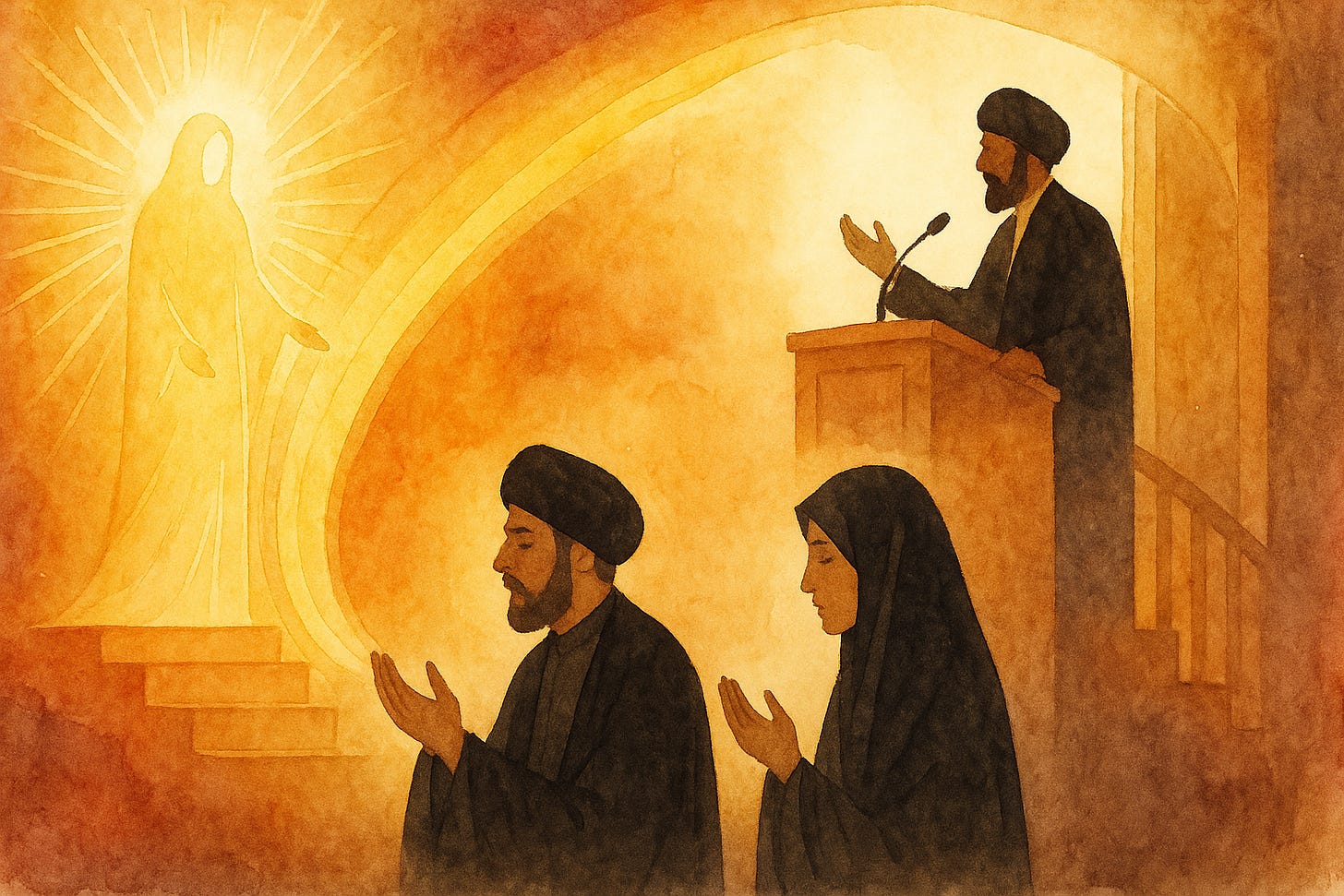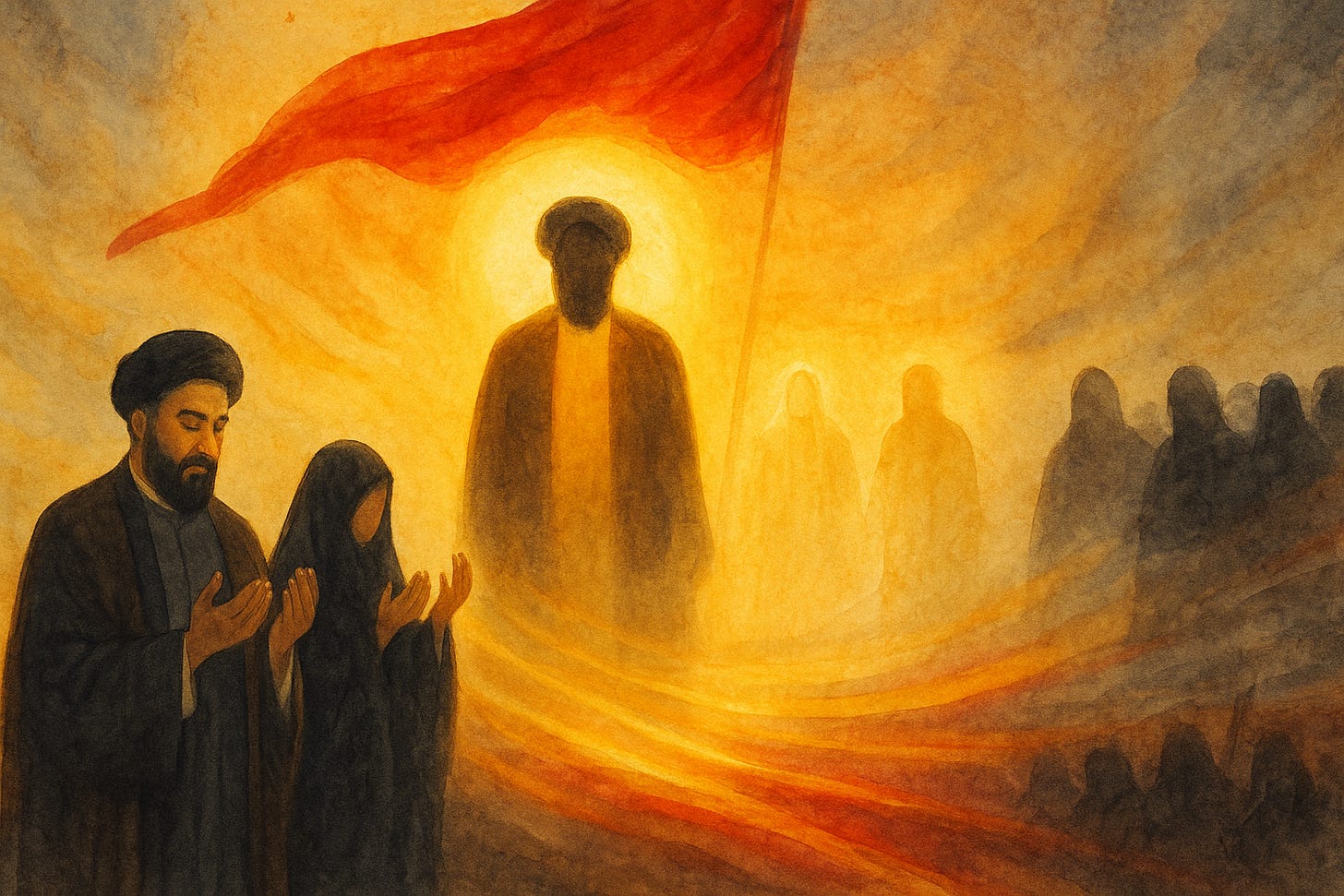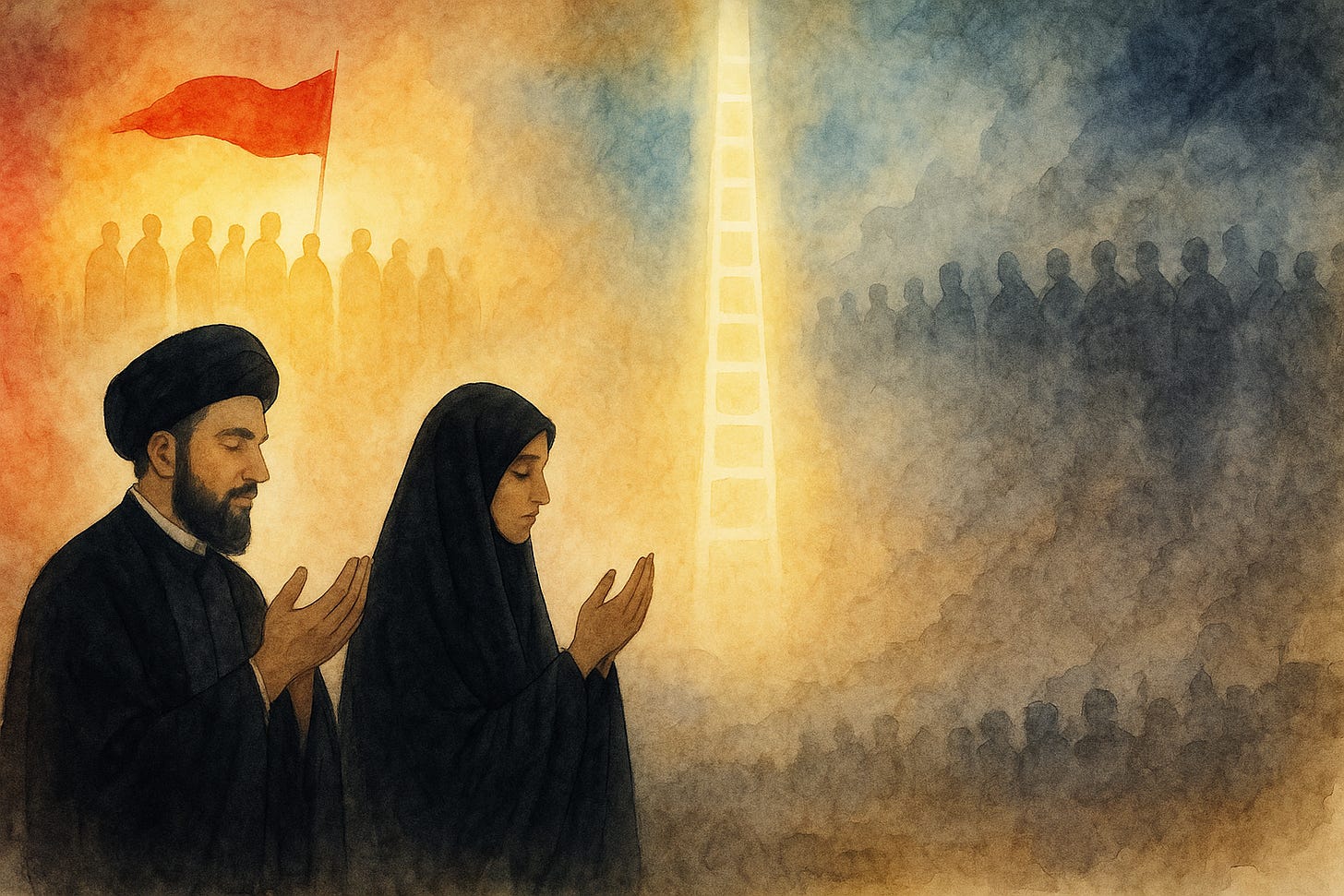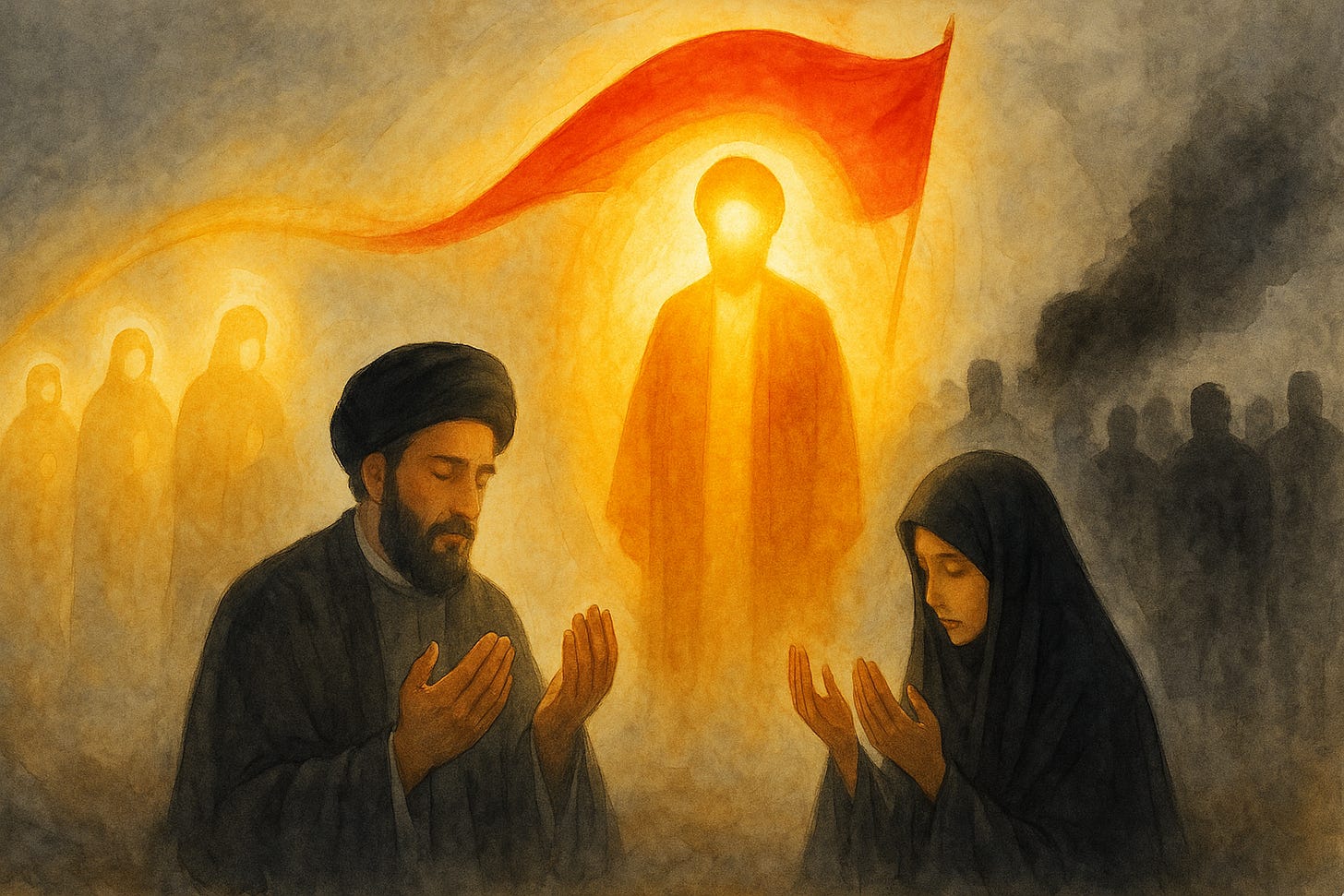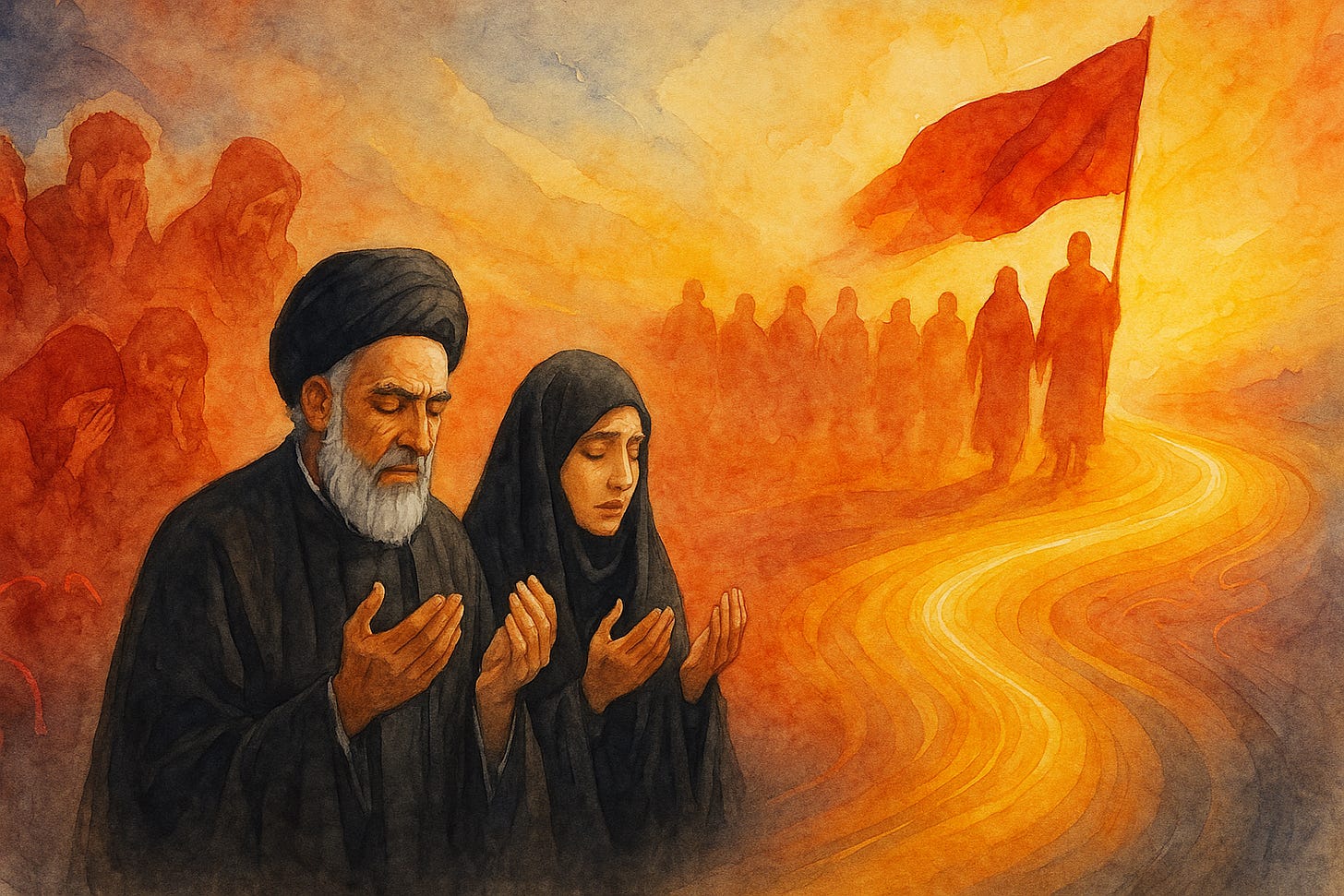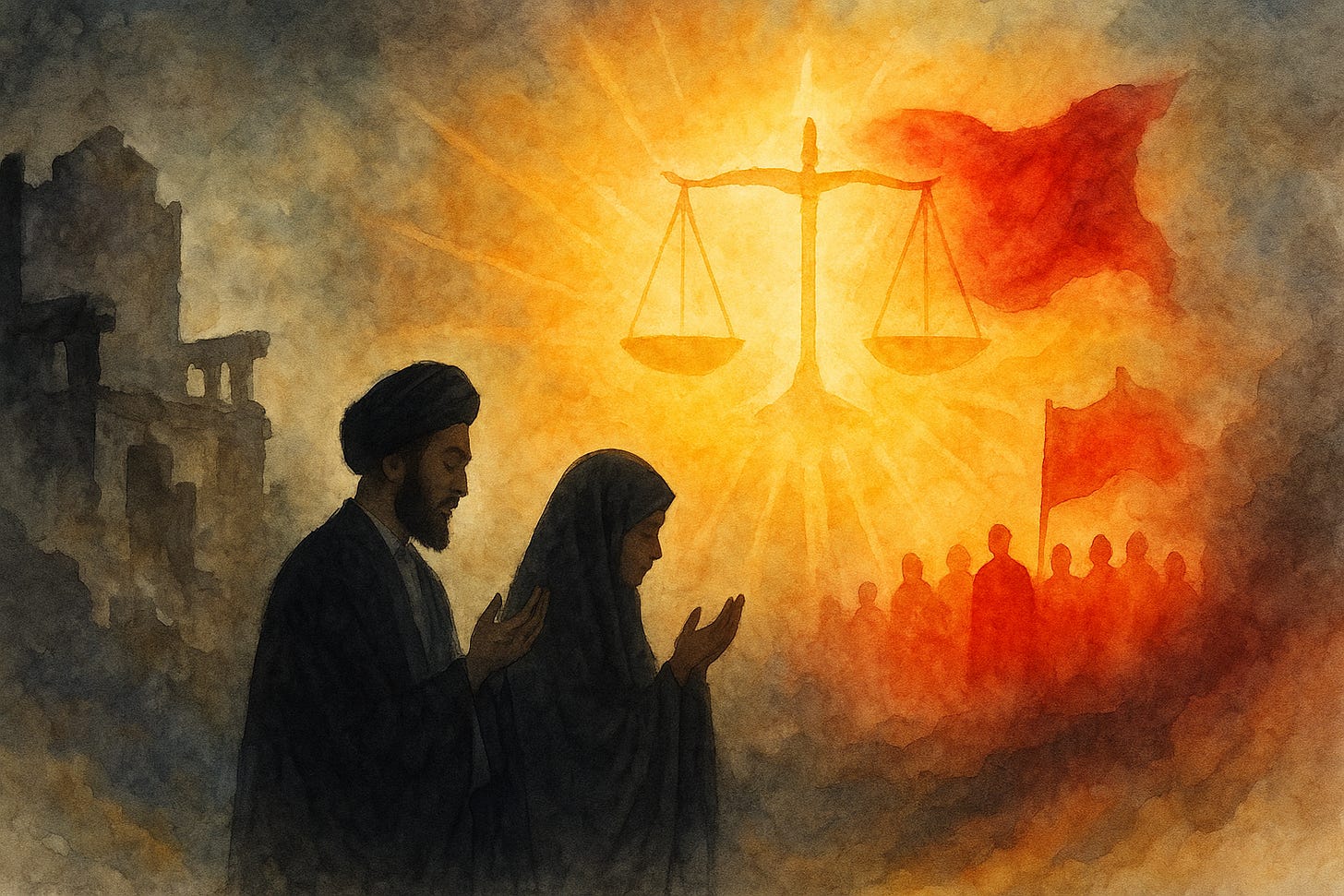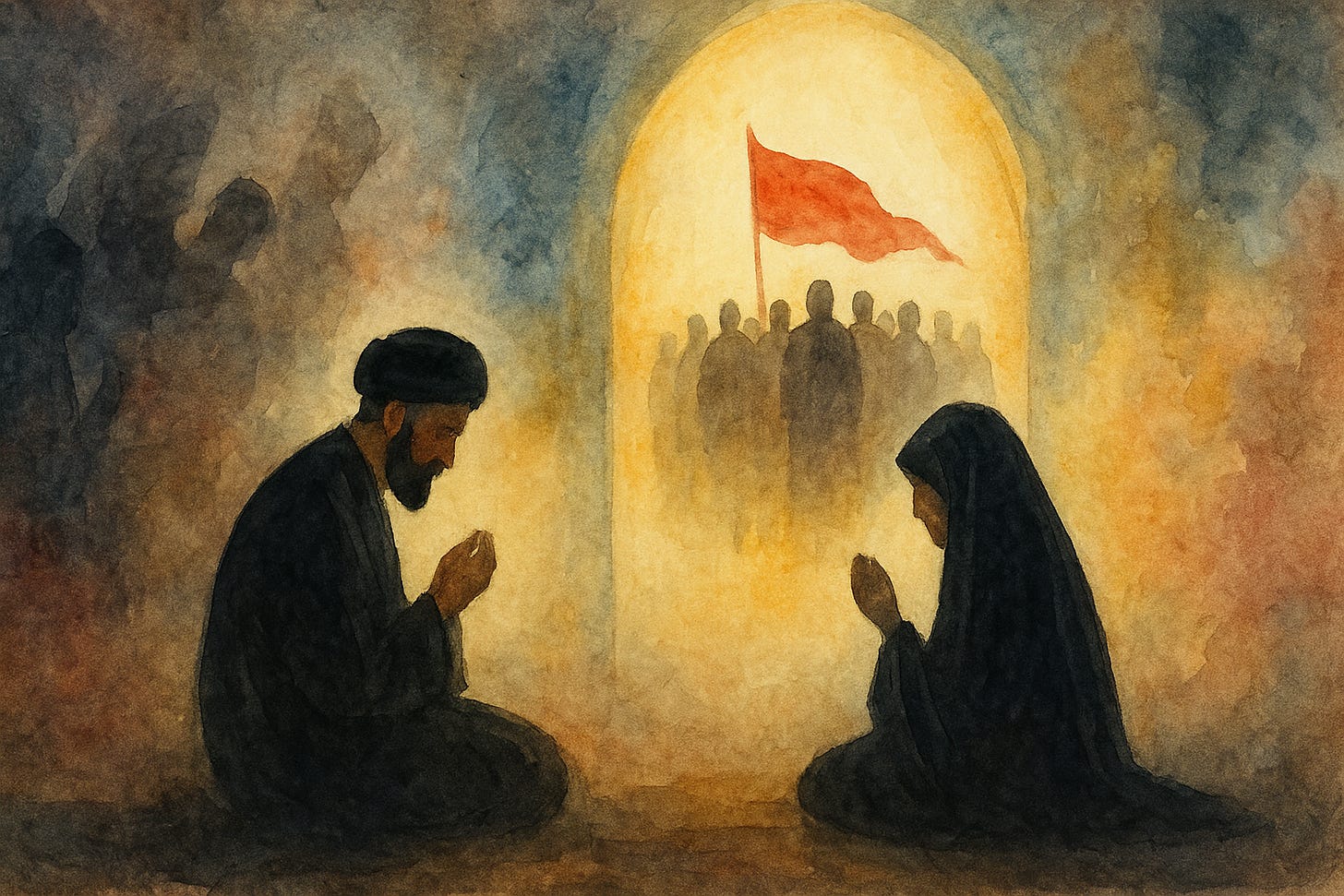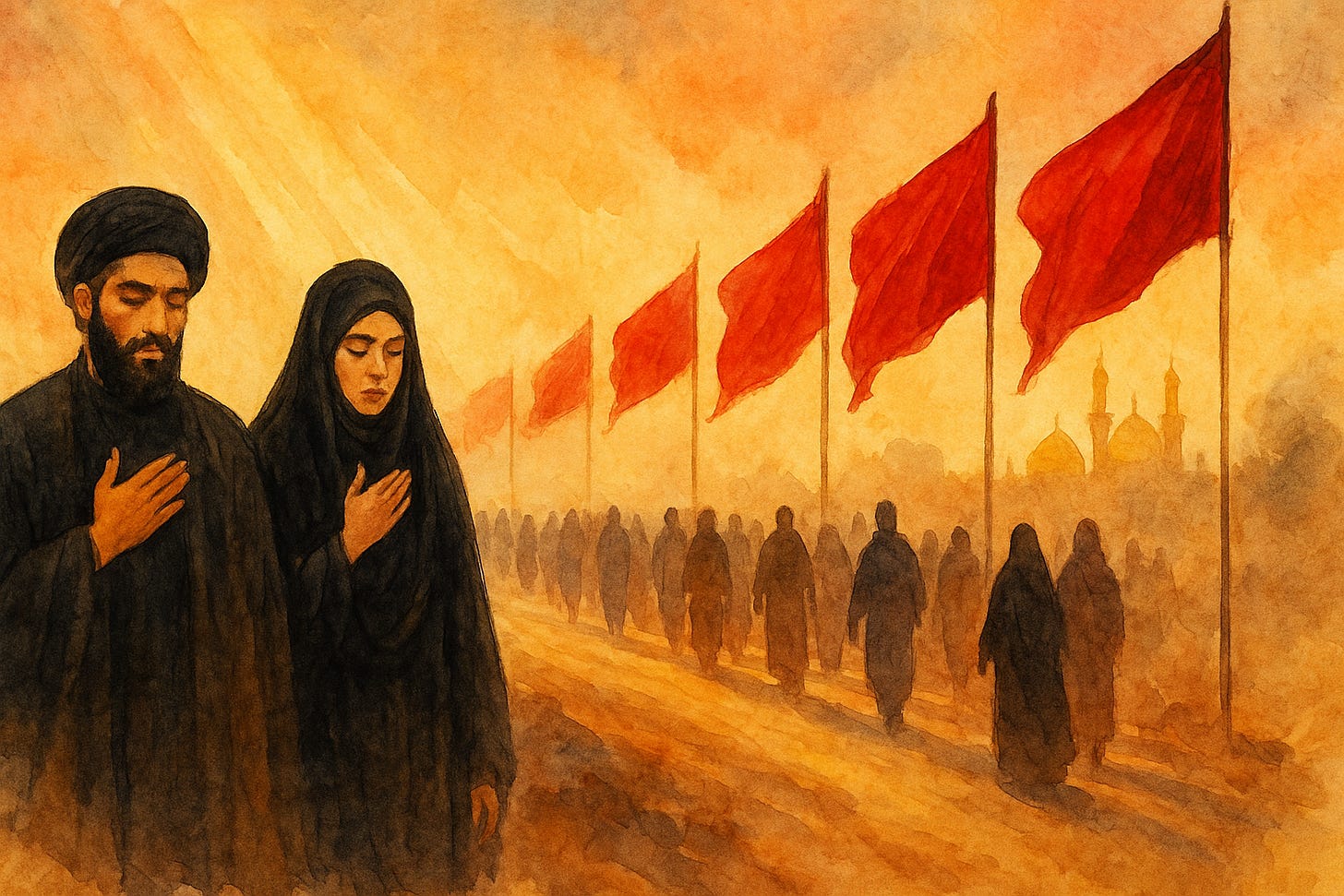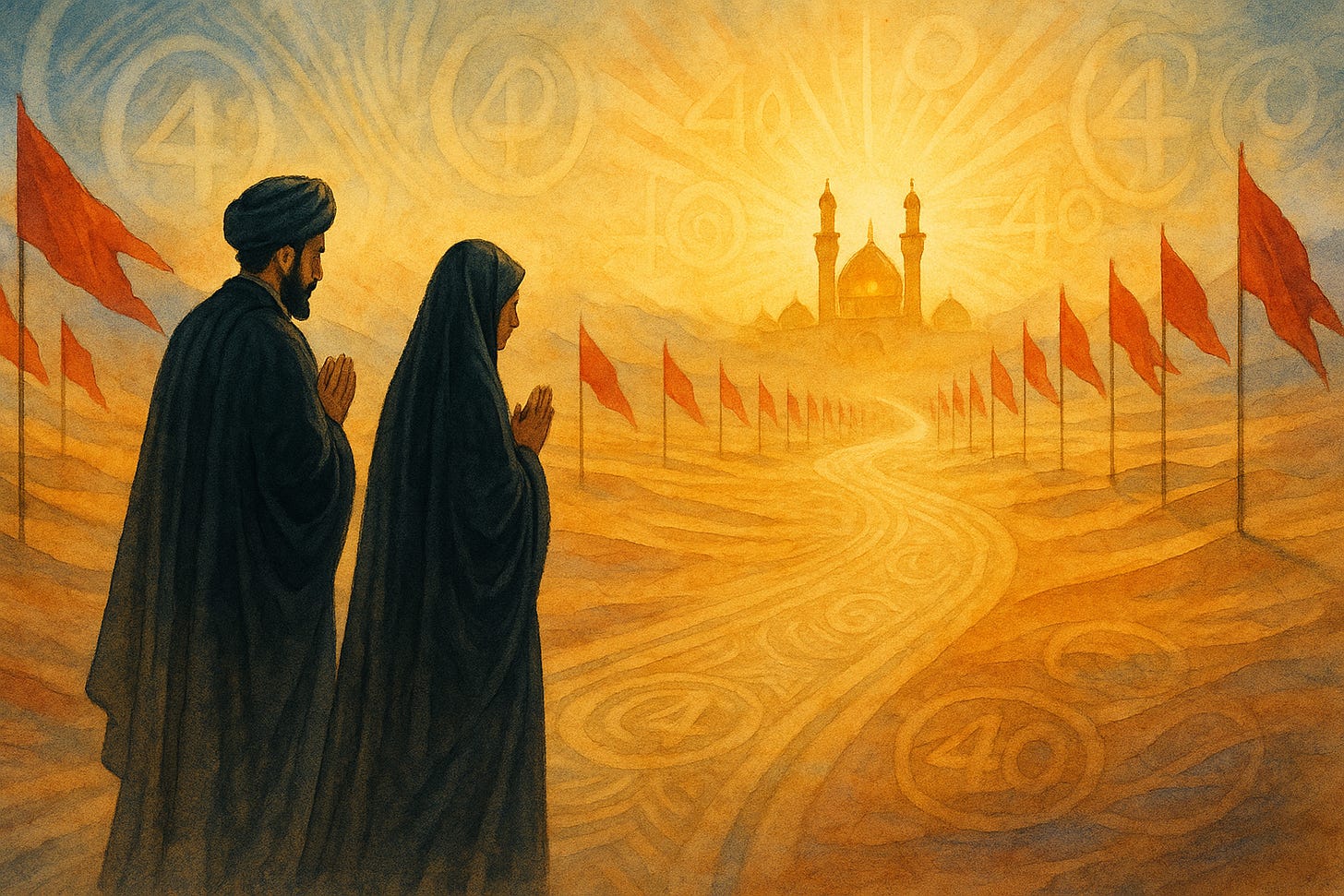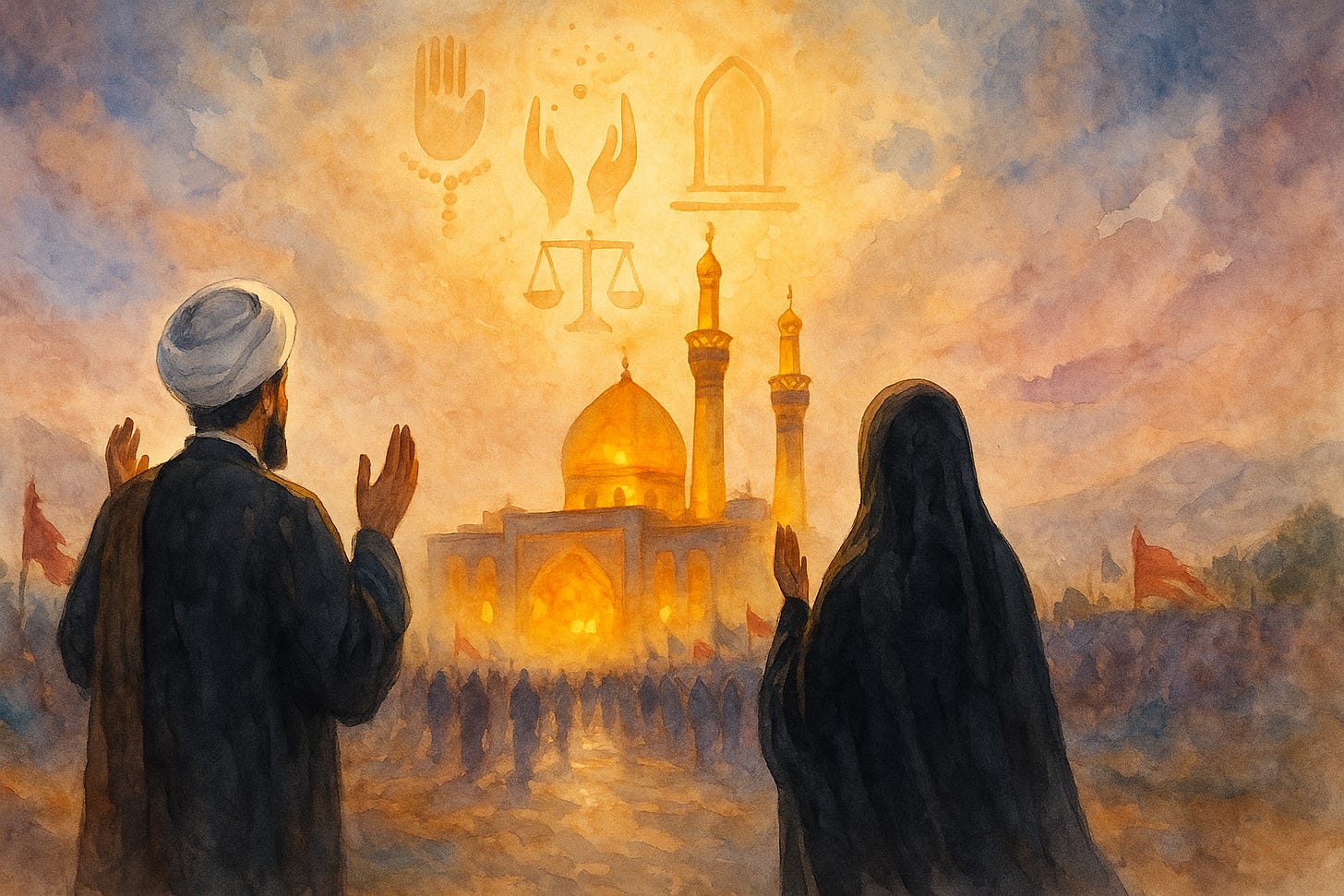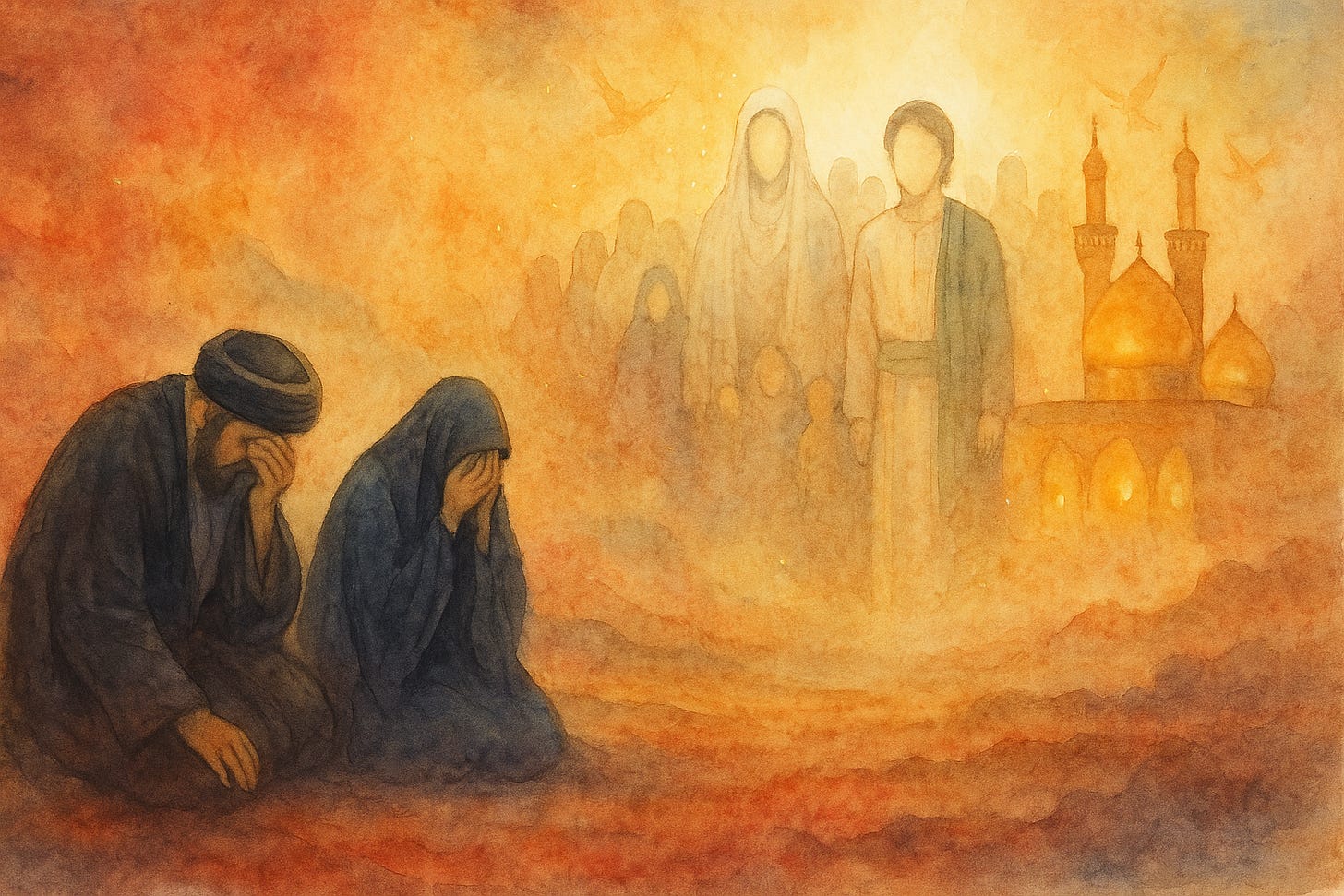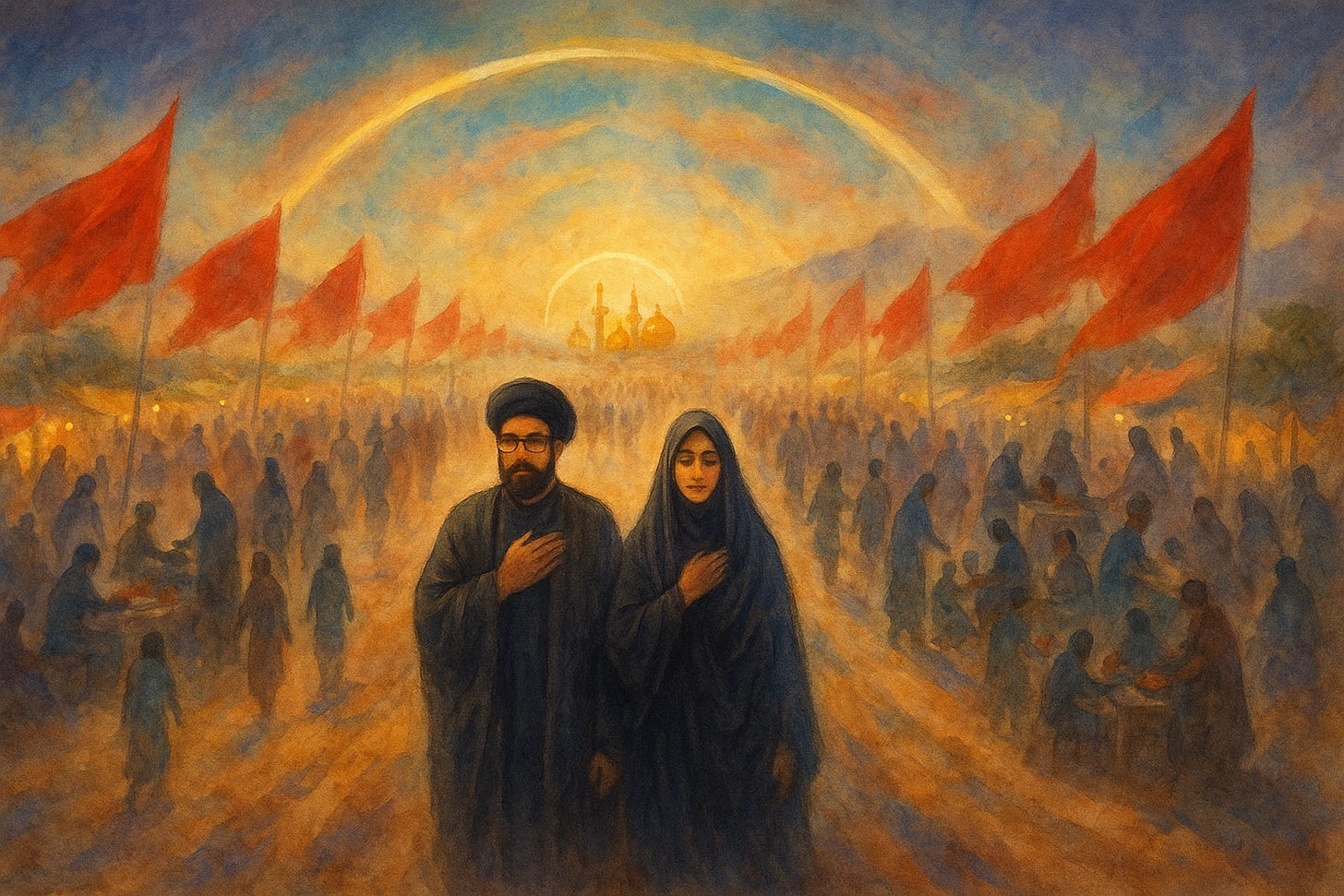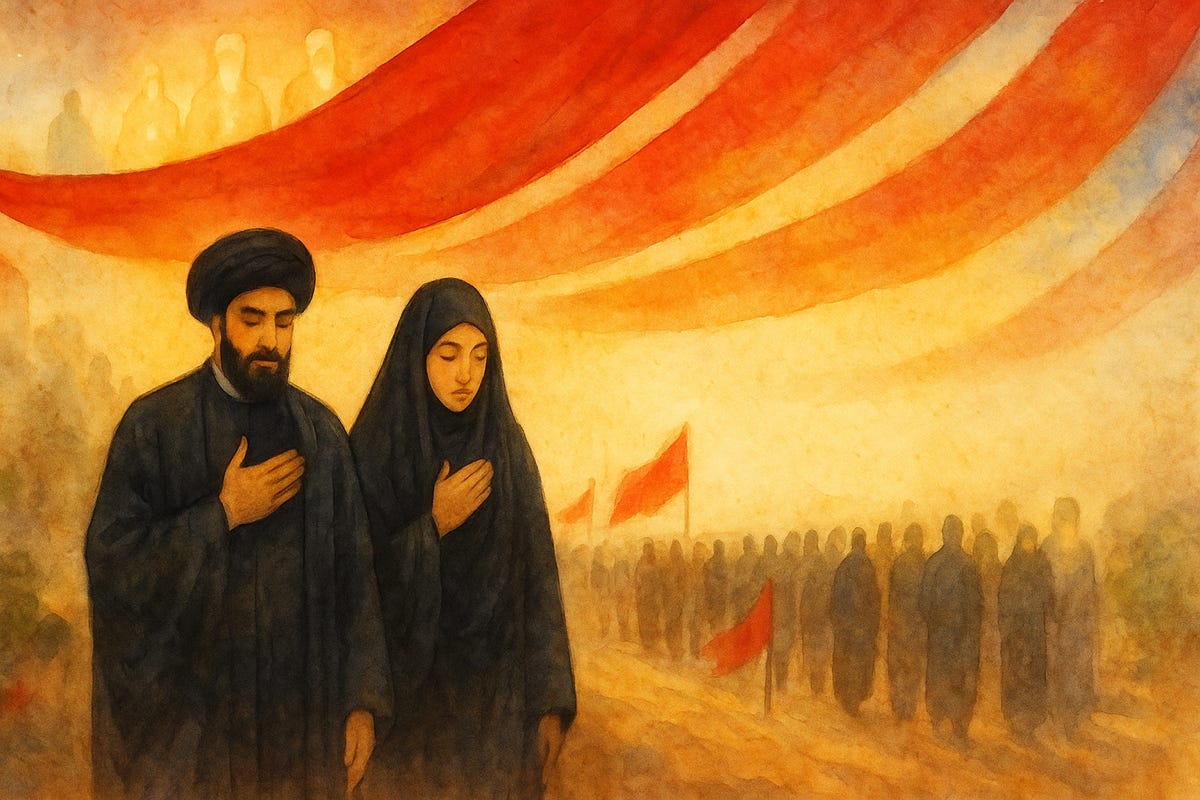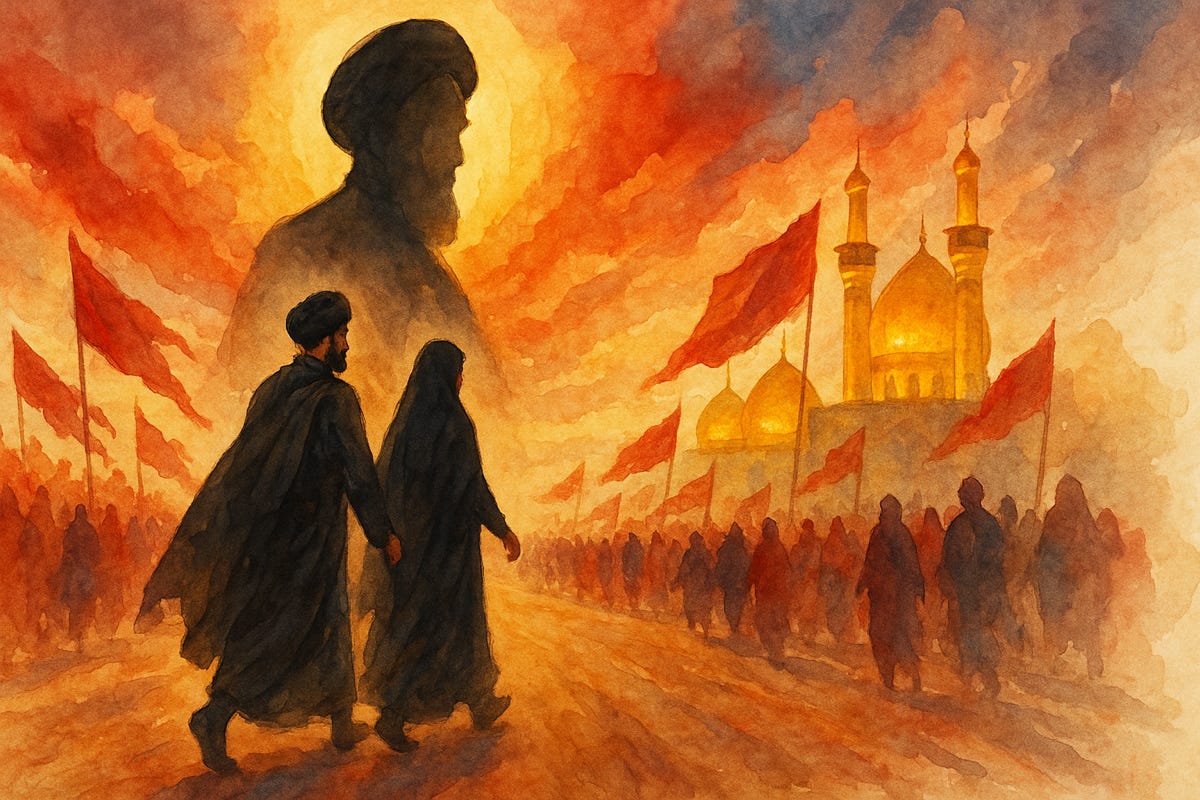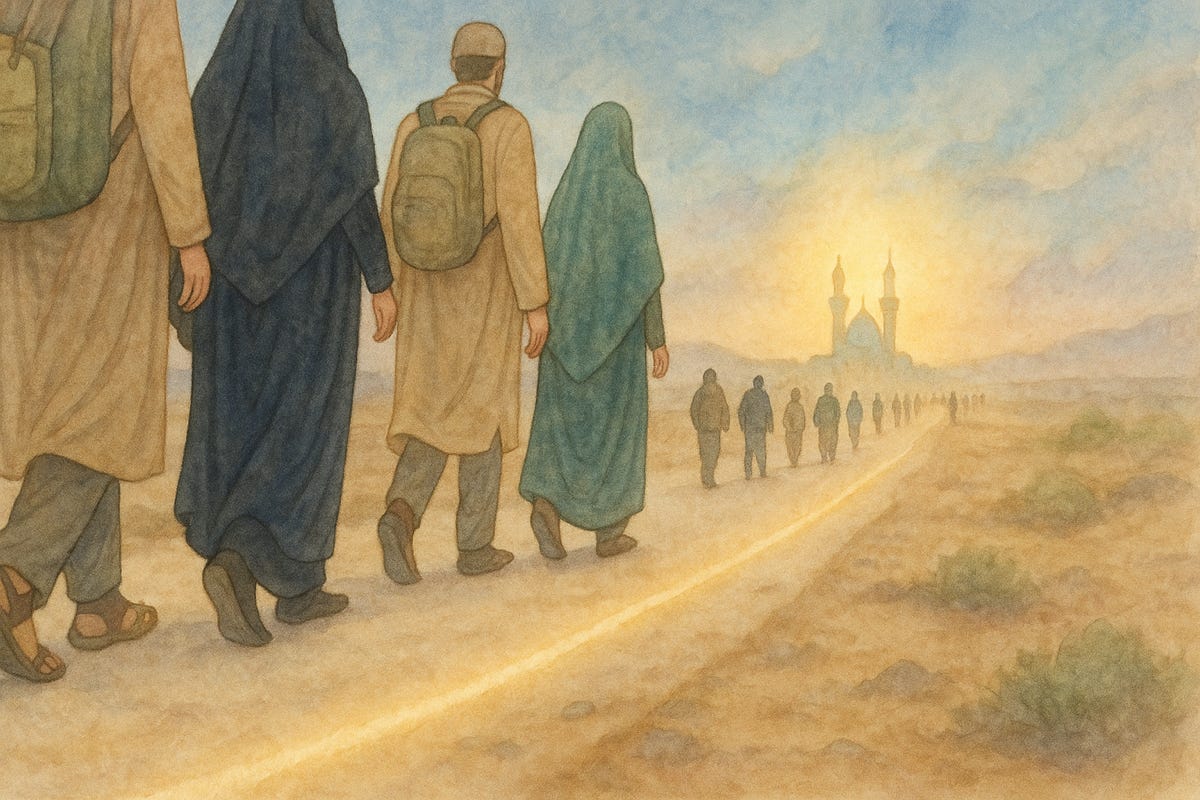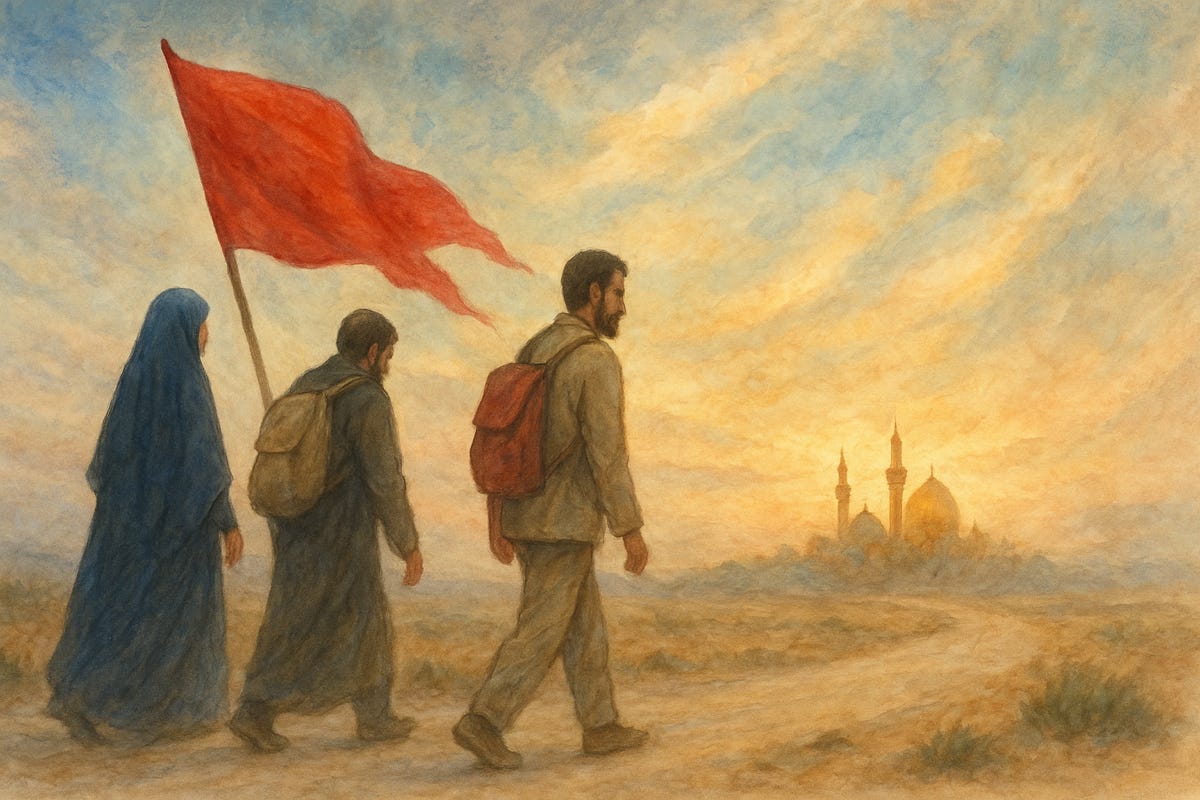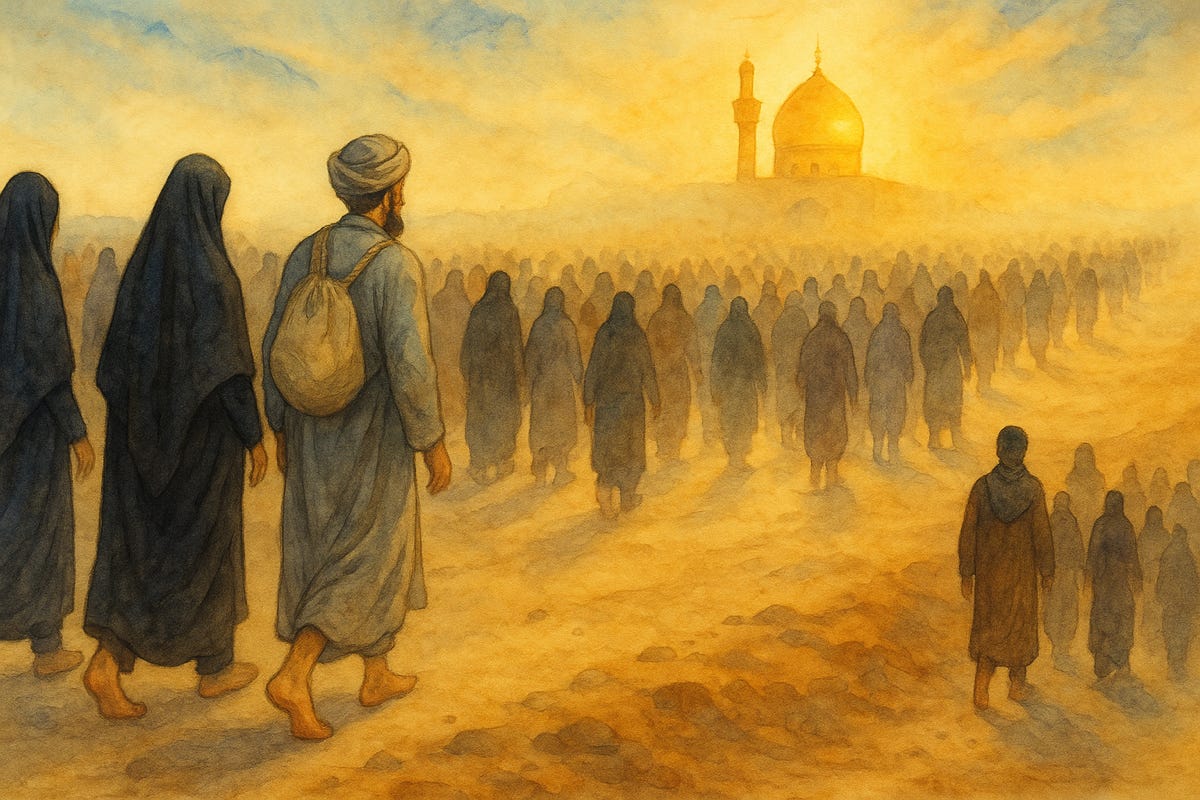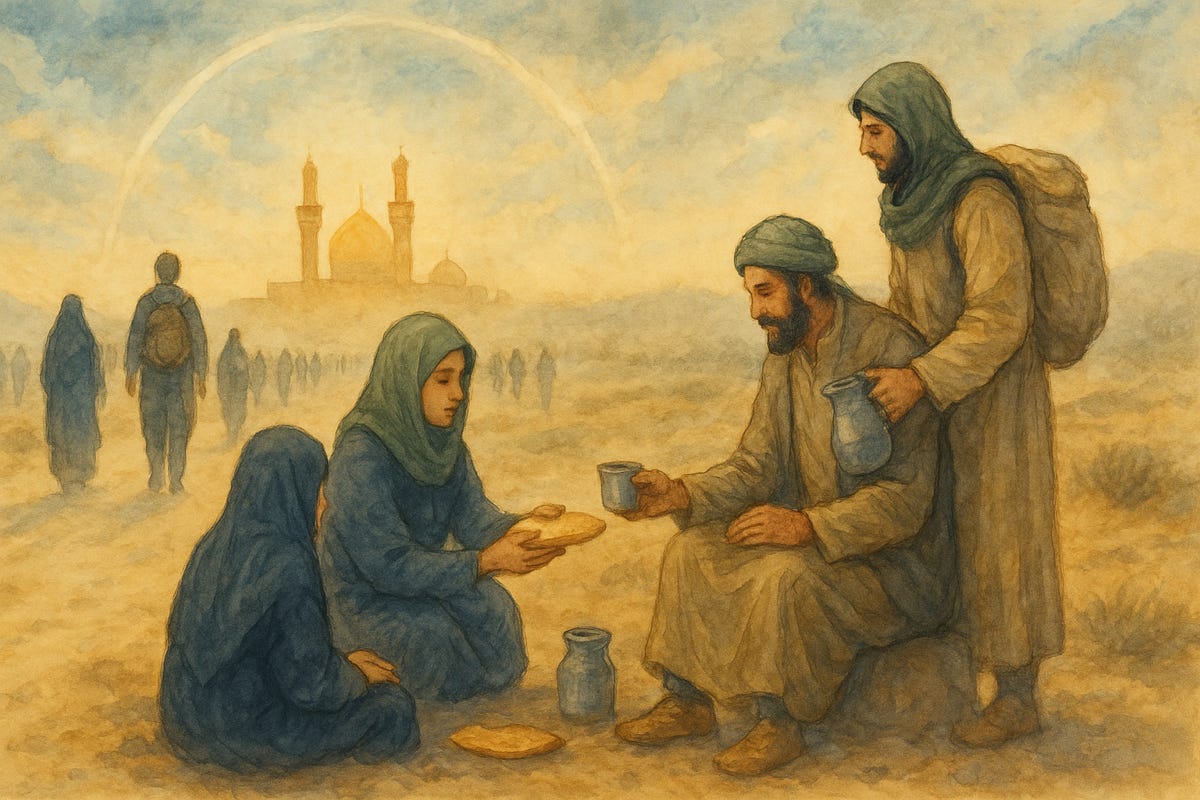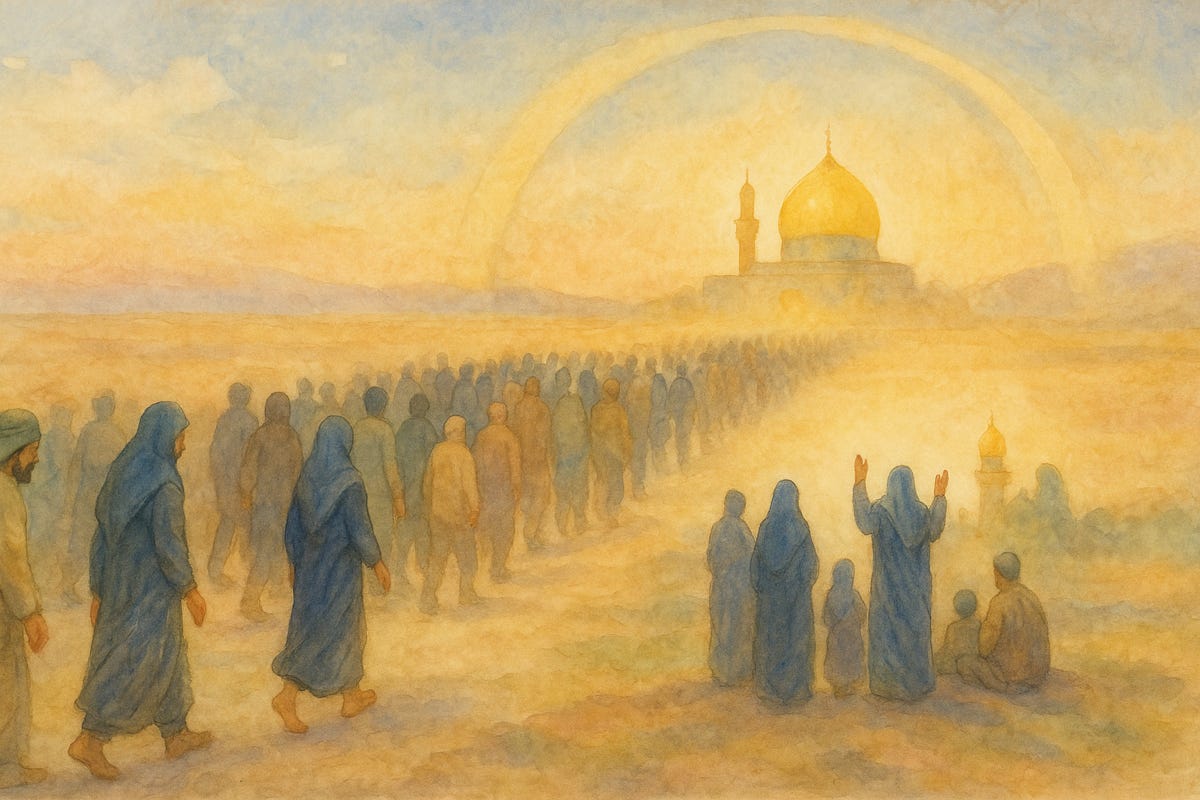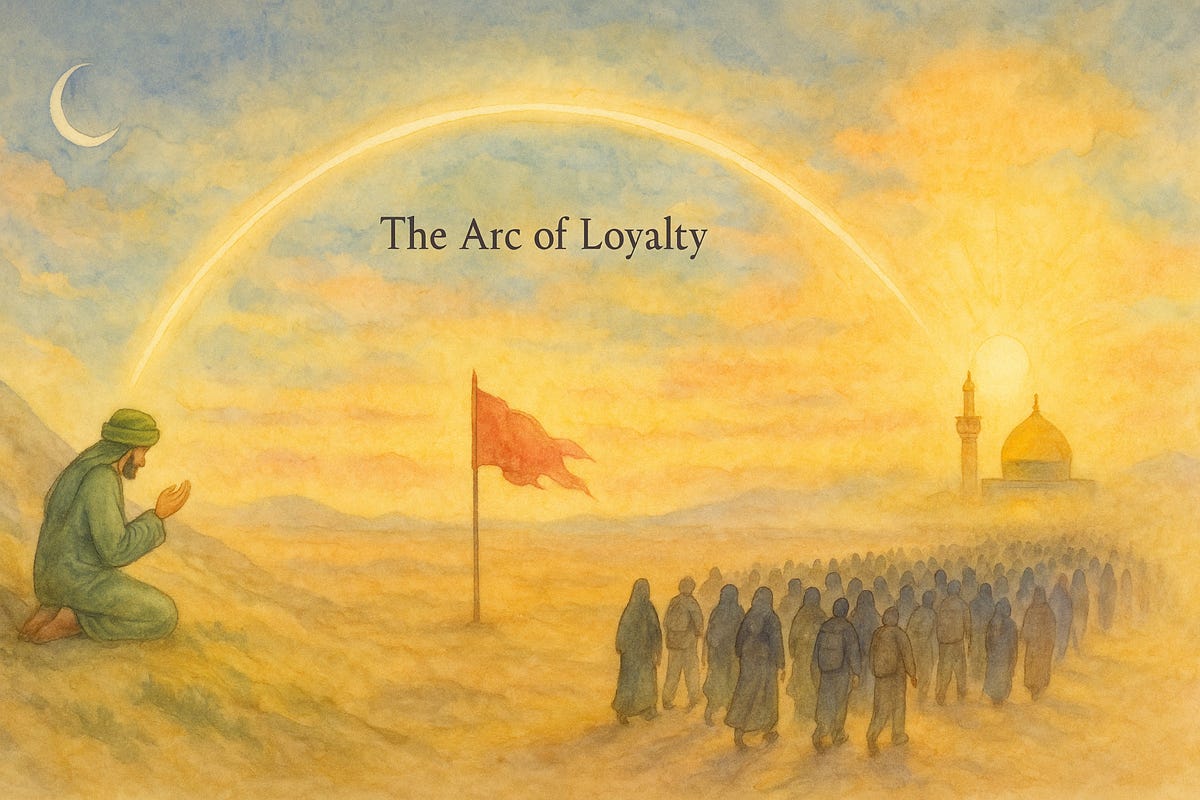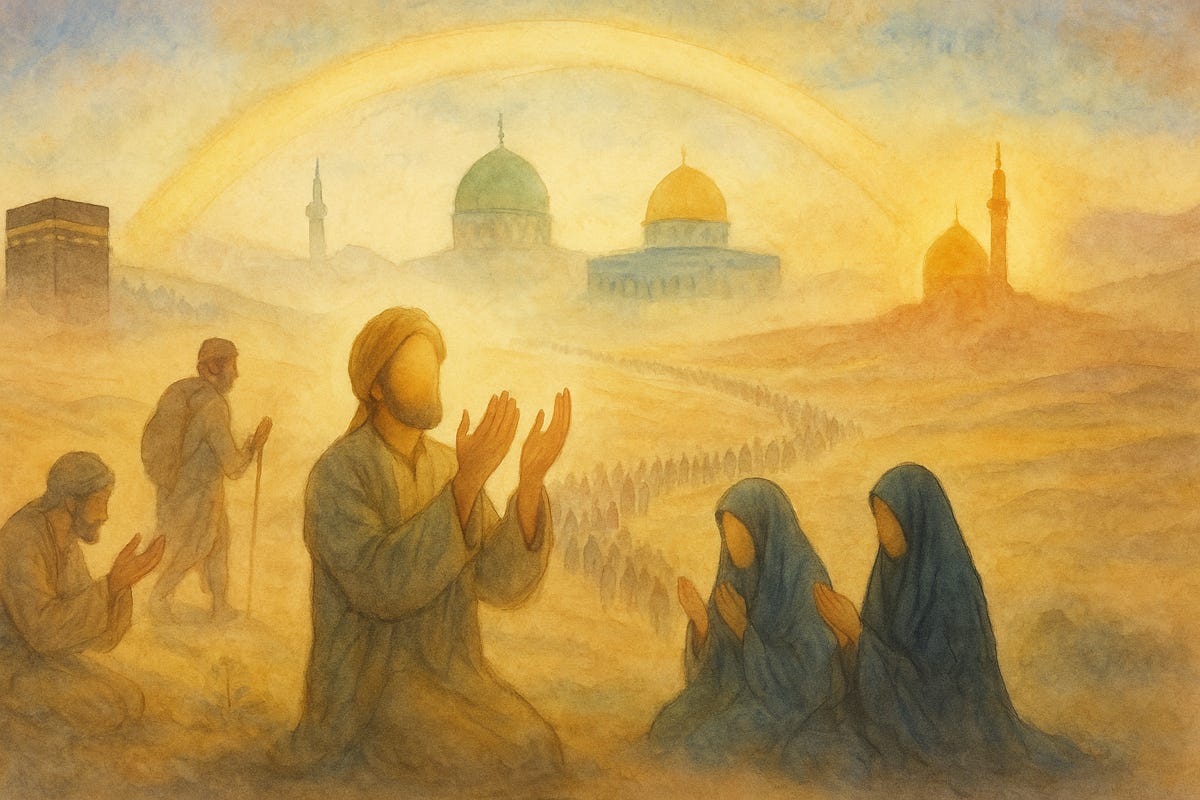[14] The Art of Supplication - The Sacred Windows: The Role of Time - Part 2: The Yearly Rhythm of Mercy - Part 3: The Arc of Loyalty
A series of discussions based on the book Uddat al-Dai wa Najah as-Saee - The Provision of the Supplicant, and the Triumph of the Seeker by Ibn Fahd al-Hilli on the subject of Supplication and Prayer.
In His Name, the Most High
This is the fourteenth part of our series, The Art of Supplication, an ongoing exploration into the sacred relationship between the supplicant, the supplication, and the Divine.
The insights within this series are cumulative, and the nature of our discussion requires that each part build upon foundations laid in the ones that came before.
To prevent any misunderstanding and to fully benefit from the depth of this subject, it is essential that you engage with the previous parts in order before continuing with this one.
The previous parts in this series can be found here:
Video of the Majlis (Sermon/Lecture)
This write up is a companion to the video majlis (sermon/lecture) found below:
Audio of the Majlis (Sermon/Lecture)
This write up is a companion to the audio majlis (sermon/lecture) found below:
Recap
The Yearly Rhythm of Mercy – Part 2: The Days of Wilayah
In our last session, we delved deeper into the sacred calendar, shifting our focus from the general seasons of mercy to the pivotal days that form the axis of our faith: the Eids of Wilayah. We explored how the covenant of divine guardianship was established through three distinct yet interconnected movements: a living testimony, a solemn proclamation, and a joyful renewal.
We established that these days are not mere historical commemorations but are living invitations that define our allegiance.
Our journey charted these three key stations:
Mubahela — The Living Testimony: We reflected on the day when supplication became an undeniable proof. When challenged by the Christian delegation of Najran, the Prophet Muhammad, by divine command, brought forth the purest souls—Imam Ali, Sayyedah Fatimah, Imam Hasan, and Imam Husayn—as the living embodiment of the Quran's call to "our sons, our women, and ourselves." This event established the Ahl al-Bayt as the divine standard of truth, demonstrating that conviction and purity are more powerful than debate or numbers.
Ghadir — The Solemn Proclamation: We journeyed to the plains of Ghadir Khumm, where the Prophet delivered the most critical message of his mission. On divine orders that tied the very completion of the faith to this announcement, he raised the hand of Imam Ali and declared, "Whomever I am his master (mawla), this Ali is his master (mawla)." This act cemented Wilayah (Guardianship) as the keystone that perfected the religion, completed God's blessing, and ensured the continuity of divine guidance through the Imamate.
Eid al-Zahra — The Joyful Renewal: Finally, we understood this day as the celebratory affirmation of the covenant. Rooted in the Quranic command to rejoice in God's bounty and mercy, this Eid is the expression of gratitude for the blessing of Wilayah. We clarified that its true significance lies in marking the beginning of the Imamate of our living Imam, al-Mahdi, representing a divinely ordained transition from the sorrows of Karbala to the forward-looking hope for his return and the establishment of justice.
Our central takeaway was that these three stations form a complete cycle: the proof (Mubahela), the pledge (Ghadir), and the joyful renewal of that pledge (Eid al-Zahra). The true spirit of these days calls us to embody the purity of Mubahela, the unifying principle of Ghadir, and the hopeful resolve of Eid al-Zahra, preparing us to be worthy servants of the Awaited Saviour.
Tonight, having explored the covenant established in light and joy, we turn to its ultimate trial. We will journey through the great arc of loyalty, a path forged not in proclamation but in sacrifice. This arc begins with the recognition and repentance on the plains of Arafah, is tested by fire and blood on the day of Ashura, and is finally affirmed by the tears and footsteps of millions on Arbaeen.
The Yearly Rhythm of Mercy — Part 3: The Arc of Loyalty
Every sacred pledge is forged in the heart, but it is in the crucible of trial that its true substance is revealed.
Having witnessed the luminous covenant of Wilayah, we now arrive at the proving grounds of that allegiance.
We turn from the festivals of proclamation to the stations of sacrifice.
Tonight, our journey takes us into the demanding Arc of Loyalty—from the soul-baring recognition at Arafah, through the ultimate test of love and blood at Ashura, to the enduring testament of devotion that is Arbaeen.
The Day of Covenant: Arafah — When Mercy Pours and Poverty Becomes Wealth
There is a day in the sacred calendar that is not merely a ritual, but a profound spiritual state; a day when the veils between the servant and the Lord grow thin, and the reality of our existence is laid bare. This is the Day of Arafah, the pinnacle of the Hajj and a universal window of mercy for all of humanity. It is a day of ma’rifah—of recognition. But what is it that we are called to recognise? The Qur’an itself sets the scene not as a physical march, but as a spiritual outpouring.
A Day Where the Veils Fall
God does not describe the gathering on the plain of ‘Arafat in static terms. He speaks of a dynamic, flowing movement of souls returning to their source. He says:
فَإِذَا أَفَضْتُم مِّنْ عَرَفَاتٍ فَاذْكُرُوا اللَّهَ عِندَ الْمَشْعَرِ الْحَرَامِ
ثُمَّ أَفِيضُوا مِنْ حَيْثُ أَفَاضَ النَّاسُ وَاسْتَغْفِرُوا اللَّهَ ۚ إِنَّ اللَّهَ غَفُورٌ رَّحِيمٌ
“Then when you stream from Arafah, remember God at the Sacred Monument…”
“Then stream out from where the people stream out, and plead to God for forgiveness; indeed God is all-forgiving, all-merciful.”
— Quran, Surah al-Baqarah (the Chapter of the Cow) #2, Verses 198-199
This is not a march of bodies but a streaming of souls. To stand at Arafah, whether in person or in spirit, is to be unmasked. In that stark, open plain under the vastness of the sky, the servant sees their own intrinsic poverty (faqr), their utter dependence on the Divine.
They realise that every status, every possession, and every breath has always been a borrowed trust.
This profound recognition of our poverty before His absolute wealth has a cosmic consequence, one that shakes the foundations of doubt and despair.
The Humiliation of Despair
This torrential downpour of Divine mercy has a powerful effect on the ultimate enemy of hope. Imam Ja’far al-Sadiq (peace be upon him) unveils for us what occurs in the unseen realms on this day:
مَا رُئِيَ الشَّيْطَانُ يَوْمًا هُوَ فِيهِ أَصْغَرُ وَلَا أَدْحَرُ وَلَا أَحْقَرُ وَلَا أَغْيَظُ مِنْهُ فِي يَوْمِ عَرَفَةَ، وَمَا ذَاكَ إِلَّا لِمَا يَرَى مِنْ تَنَزُّلِ الرَّحْمَةِ وَتَجَاوُزِ اللَّهِ عَنِ الذُّنُوبِ الْعِظَامِ
"Never is Satan seen more abased, more driven off, more humiliated, and more enraged than on the Day of Arafah—and that is for no other reason than that he beholds the descent of mercy and God’s pardoning of great sins."
— Al-Kulayni, al-Kafi, Volume 4, Page 261, Kitab al-Hajj (the Book of Hajj), Chapter on the Virtue of the Day of Arafah (Bab Fadhl Yawm Arafah), Hadith 5
Satan’s greatest weapon is despair. He whispers that our sins are too great, our past too dark, and God’s forgiveness too distant. But on the Day of Arafah, when the heavens pour mercy in such abundance that even the gravest sins are washed away, despair itself is unmasked as a lie. The sheer scale of God's forgiveness silences the whispers of hopelessness.
Knowledge Transformed into Gratitude
This recognition of mercy finds its most sublime human expression in the voice of the Master of Martyrs, Imam al-Husayn (peace be upon him), on that very plain. His supplication on the Day of Arafah is not a mere list of requests; it is a testament of lived theology, where creed is turned into trembling gratitude.
He begins not by asking, but by knowing:
الْحَمْدُ لِلّٰهِ الَّذِي لَيْسَ لِقَضَائِهِ دَافِعٌ، وَلَا لِعَطَائِهِ مَانِعٌ، وَلَا كَصُنْعِهِ صُنْعُ صَانِعٍ
"All praise belongs to God, whose decree none can repel, whose gift none can withhold, and whose making none can match..."
— Shaykh Abbas al-Qummi, Mafatih al-Jinan, Section on the Amaal of the Day of Arafah
— Al-Majlisi, Bihar al-Anwar, Volume 95, Page 213
In this school of supplication, Imam al-Husayn teaches us that to truly know God is to thank Him, and to truly thank Him is to know Him more deeply. He names every limb, every faculty, every breath, and every moment of existence as a direct and unearned mercy from God. This is the heart of Arafah: knowledge transforming into gratitude, and gratitude deepening into gnosis.
The Gnosis of the Scholars
This profound understanding—that Arafah is a school of Divine knowledge built on the foundation of our own poverty—echoes throughout the works of our great scholars.
Allamah Tabatabai explains the essence of supplication itself, which finds its peak on this day:
الدُّعَاءُ هُوَ الْعِبَادَةُ بِعَيْنِهَا؛ لِأَنَّهُ تَجَلٍّ لِفَقْرِ الْعَبْدِ وَاعْتِرَافِهِ بِالْقُرْبِ الْإِلَهِيِّ
“Dua is worship itself, for it is the manifestation of the servant’s poverty and his acknowledgement of divine nearness.”
— Allamah Tabatabai, al-Mizan fī Tafsir al-Quran, Volume 2, Page 34, Commentary on Surah al-Baqarah (the Chapter of the Cow) #2, Verse 186
Imam Khomeini describes the day as a practical lesson in gnosis:
يَوْمُ عَرَفَةَ مَدْرَسَةُ مَعْرِفَةِ اللهِ؛ دُعَاءُ الْحُسَيْنِ فِيهِ هُوَ عِرْفَانٌ عَمَلِيٌّ، يُعَلِّمُنَا أَنَّ كُلَّ ذَرَّةٍ مِنْ وُجُودِنَا رَحْمَةٌ إِلَهِيَّةٌ
“The Day of Arafah is a school of knowing God. The supplication of Husayn within it is practical gnosis, teaching us that every particle of our being is divine mercy.”
— Imam Khomeini, Adab al-Salaat (The Disciplines of Prayer), Lesson 8
Ayatullah Jawadi Amoli beautifully articulates the spiritual transaction that occurs:
يَوْمُ عَرَفَةَ يَوْمُ رُجُوعِ الْإِنْسَانِ إِلَى فَقْرِهِ الْأَصِيلِ، وَبِهَذَا الرُّجُوعِ يَكُونُ غَنِيًّا بِاللهِ
“The Day of Arafah is the day when man returns to his essential poverty, and in this very return, he becomes enriched by God.”
— Ayatullah Jawadi Amoli, Tafsir al-Tasnim, Volume 10, Page 415
And Ayatullah Bahjat reminds us of the urgency of this divine opportunity:
يَوْمُ عَرَفَةَ يَوْمٌ لَا يُرَدُّ فِيهِ دُعَاءُ مُضْطَرٍّ. عَلَى الْمُؤْمِنِ أَنْ يَغْتَنِمَهُ قَبْلَ الْغُرُوبِ
“The Day of Arafah is a day when the dua of the distressed is not rejected. A believer must seize the opportunity before the sun sets.”
— Ayatullah Bahjat, Nafahat-e-Haqiqi
From the Plain of Arafat to the Plains of Our Time
This recognition of Divine mercy and human poverty is not a historical lesson confined to a sacred geography.
It is the essential lens through which the believer must view the world today. When we look upon the plains of our own time, we see immense distress.
We see the blood of innocents crying out from the soil of Gaza, Sudan, and Kashmir.
We witness a world that devalues the sacred gift of life, where the unborn are aborted for convenience, and the elderly are encouraged to end their lives because they are deemed a burden to their offspring or to society.
We see a humanity starved of love and compassion, where hatred and vile behaviour erupt from all sides of the social and political spectrum, poisoning the very air we breathe.
The natural human response is often one of two extremes: either a paralyzing despair at the scale of the injustice, or an arrogant belief that human solutions alone can fix a world so deeply broken.
The lesson of Arafah offers a third path—the path of the servant. It teaches us to be reflective. It calls us to witness this suffering not as a sign of God's absence, but as a stark reflection of humanity's distance from Him.
The covenant of Arafah is to see all this brokenness and to yield. We turn back to God and confess not only our own sins, but our collective powerlessness.
We recognise that He is both the source-point of all creation and the destination-point of all affairs.
We affirm that only He can remedy this state, for the power that spread the earth and humiliated Satan is the only power that can heal a fractured humanity and bring justice to the oppressed.
This is not an abdication of responsibility; it is the correct orientation for all righteous action.
The Covenant Clarified: Our Takeaways
Therefore, as we reflect on this Day of Covenant, let us clarify the essential truths we must carry with us. Let these be the non-negotiable takeaways from this sacred school:
True Wealth is in Recognised Poverty: The first step towards God is to understand our absolute need for Him. Arafah teaches us that it is only by embracing our existential poverty (faqr) that we open ourselves to the limitless wealth (ghina) of God’s mercy, power, and forgiveness.
Mercy Annihilates Despair: The boundless forgiveness poured out on Arafah is a definitive divine statement: God’s mercy is greater than any sin. Let this truth be a shield against the whispers of Satan, whose primary weapon is to convince you that you are beyond repair. On this day, despair itself is defeated.
Gnosis Demands Gratitude: True knowledge of God is not an abstract intellectual exercise. As embodied in the supplication of Imam al-Husayn, authentic gnosis (ma’rifah) blossoms into a state of profound and trembling gratitude for every moment of our existence. To know Him is to thank Him.
The Spiritual Orients the Social: Our response to the world’s injustices must begin with this spiritual re-orientation. Before we act, we must first turn to God, recognising Him as the ultimate agent of change and justice. All our efforts for good in this world must be rooted in the knowledge that He is the source of all solutions and the final recourse for the oppressed.
The Day of Sacrifice – Ashura: When Loyalty Bleeds and Truth Stands Alone
There comes a day in the sacred calendar when loyalty is not declared with words, but with blood. A day when the covenant made on Arafah is tested by fire. A day when everything is taken, and yet God is still praised.
This is the Day of Ashura — the day of Imam al-Husayn (peace be upon him).
Not just a day of mourning, but a day of measure: to what extent are we truly loyal?
What are we willing to give? And will we still choose the path of God when it no longer gives us comfort, but demands sacrifice?
A Day Written in Blood and Light
The Quran alludes to days that shake the fabric of history. Ashura is one of them. Though its name is not mentioned directly, its essence is echoed in divine words:
وَاللَّيْلِ إِذَا يَسْرِ
وَالصُّبْحِ إِذَا تَنَفَّسَ
إِنَّ فِي ذَٰلِكَ لَقَسَمًا لِّذِي حِجْرٍ“By the night as it departs,
And by the dawn as it breathes —
Indeed in that is a sign for those of intellect.”— Quran, Surah al-Fajr (the Chapter of the Dawn) #89 Verse 4–5
The night that fled and the dawn that sighed — these are the hours of Ashura.
The night before, spent in dua, Quran, and whispered farewells. The morning of — a sigh from the soul of the world as the blood of the Prophet’s family soaked the sands of Karbala.
The Stand That Redefined History
Imam al-Husayn did not ride out seeking death. He sought life — real life — the life of the spirit and the revival of the Ummah.
In one of his most important addresses leading up to the day of Ashura, he proclaimed:
أَلَا إِنَّ الدَّعِيَّ ابْنَ الدَّعِيِّ قَدْ رَكَزَ بَيْنَ اثْنَتَيْنِ: بَيْنَ السِّلَّةِ وَالذِّلَّةِ، وَهَيْهَاتَ مِنَّا الذِّلَّةُ!
“Behold! The illegitimate son of an illegitimate man has given me a choice between the sword and humiliation. But far from us is humiliation!”
— Al-Majlisi, Bihar al-Anwar, Volume 45, Page 51
This was no political slogan. It was a theological stance — hayhat minna al-dhillah — the refusal to compromise truth for survival.
In this, Imam Husayn became the living Quran, re-enacting the prophetic mission with the ink of blood and the parchment of sand.
The Witnesses of Loyalty
Around him stood a fellowship like no other.
Men, women, and children — each one fulfilling the covenant made on Arafah with complete clarity.
Qasim, who cried out: “Death is sweeter than honey.”
Ali al-Akbar, whose face the enemy described as the most similar to the Messenger of God.
Abdul Fadhl al-Abbas, who gave everything — both arms — for the sake of loyalty.
Sayyedah Zaynab, whose eloquence shattered Yazid’s throne more surely than any sword.
This is why the Prophet (peace and blessings be upon him and his family) said:
إِنَّ لِقَتْلِ الْحُسَيْنِ حَرَارَةً فِي قُلُوبِ الْمُؤْمِنِينَ لَا تَبْرُدُ أَبَدًا
“Indeed, for the killing of Husayn there is a burning in the hearts of the believers that will never cool.”
— Al-Hurr al-Ameli Wasa’il al-Shia, Volume 14, Page 504
The Divine Response: Did You Find What Your Lord Promised You to Be True?
Even as their bodies fell, the souls of the martyrs soared. When Sayyedah Zaynab stood over the mutilated body of her brother, she did not collapse.
She turned her face to the heavens and said:
اللَّهُمَّ تَقَبَّلْ هَذَا الْقُرْبَانَ
“O God, accept this sacrifice!”
And later, in the court of Yazid, when asked what she saw, she replied:
مَا رَأَيْتُ إِلَّا جَمِيلًا
“I saw nothing but beauty.”
This was not delusion. It was ma’rifah. The same ma’rifah of Arafah, now crowned in Karbala.
The same recognition of Divine mercy, now bathed in blood.
From the Pulpit of Karbala to the Pulpits of Today
How the Scholars of Resistance Inherit and Clarify the Stand of Husayn
The tragedy of Ashura is not a historical memory to be preserved—it is a living legacy to be enacted.
From the pulpit of Sayyedah Zaynab in Damascus to the minbars of our time, the Husayni message lives on through those who clarify the truth, stand firm in hardship, and refuse to allow the blood of the martyrs to be forgotten or distorted.
Let us now look at the words of scholars and leaders who have inherited the trust of tabyeen (clarification), drawing from the eternal wellspring of Karbala to guide their ummah in an age of deception.
Imam Khomeini: Ashura as the Eternal Movement of Uprising Against Oppression
این محرم و صفر است که اسلام را زنده نگه داشته است.
“It is Muharram and Safar that have kept Islam alive.”
ما باید همه چیز خود را برای اسلام بدهیم، همانطور که امام حسین علیهالسلام داد.
“We must give everything we have for Islam, just as Imam Husayn (peace be upon him) gave everything.”
ما عاشورا را زنده نگه داشتهایم تا با ظلم بجنگیم؛ هر روز عاشوراست و هر زمین، کربلا.
“We have kept Ashura alive so that we may fight injustice; every day is Ashura and every land is Karbala.”
— Imam Khomeini, Sahifa-ye Imam, vol. 15, p. 331; also from various speeches in 1979–1981
Imam Khamenei: Ashura as the Measure of Sincerity and Clarification
عاشورا یک درس است، یک معیار است.
“Ashura is a lesson; it is a criterion.”
اگر بخواهیم بفهمیم حق با کیست، باید ببینیم چه کسی حسینی است و چه کسی یزیدی.
“If we wish to know where the truth lies, we must see who is with Husayn and who is with Yazid.”
اگر امام حسین علیهالسلام نبود، اسلام نمیماند.
“Were it not for Imam Husayn (peace be upon him), Islam would not have endured.”
اگر امروز ما حقیقت را کتمان کنیم، از اصحاب امام حسین نیستیم.
“If we conceal the truth today, then we are not among the companions of Husayn.”
— Imam Khamenei, Sermon on Ashura, 10 Muharram 1410 AH / 1989 CE, and various other Ashura addresses
Ayatullah Sayyed Muhammad Husayn Fadhlullah: Ashura as the Theological Foundation of Social Justice
إنّ الحسين هو الذي فجّر الوعي في الأمة، وحرّك المشاعر، وركّز المعاني.
“It was Husayn who awakened consciousness in the Ummah, stirred emotion, and deepened meaning.”
الحسين لم يخرج ليبكي الناس، بل ليُقيم العدل، وليفضح الباطل، وليُحيي الحقّ.
“Husayn did not rise to make people weep, but to establish justice, expose falsehood, and revive truth.”
علينا أن نُحوّل عاشوراء من مأساة إلى مشروع؛ من دمعة إلى حركة.
“We must transform Ashura from a tragedy into a project—from a tear into a movement.”
— Ayatullah Fadhlullah, Min Wahy al-Mimbar, Volume 10, Khutbah for Ashura
Sayyed Hassan Nasrallah: Ashura as the Strategy of Dignified Resistance
كلُّ يومٍ عاشوراء، وكلُّ أرضٍ كربلاء، حين تُقابَلُ الكرامةُ بالذلِّ، وتُقابَلُ الحقيقةُ بالكذب.
“Every day is Ashura, and every land is Karbala, whenever dignity is met with humiliation and truth is met with lies.”
من يريد أن يعرف من نحن، فلينظر إلى كربلاء، إلى الحسين، إلى زينب.
“Whoever wishes to know who we are should look to Karbala, to Husayn, to Zaynab.”
نحن أنصار الحسين في وجه كلّ يزيد جديد.
“We are the supporters of Husayn in the face of every new Yazid.”
نحن نواجه القتل والتفجير لأننا نرفض أن نكون عبيداً لأمريكا وإسرائيل.
“We face death and bombings because we refuse to be slaves of America and Israel.”
— Sayyed Hassan Nasrallah, Ashura speeches (2006, 2013, 2020) (Quoted extensively in “Hawla Khitabat al-Sayyed al-Shaheed” (About the Speeches of the Martyred Sayyed), Dar al-Wafa
Shaykh Naeem Qassem: Ashura as the School of Loyalty and Sacrifice
إن كربلاء علّمتنا أن الدفاع عن الحق لا يُقاس بالعدد بل بالإيمان.
“Karbala taught us that the defence of truth is not measured by numbers, but by faith.”
الإمام الحسين خطٌّ بيانيٌّ للمسيرة الربّانية، يُظهر أنّ التضحية هي سُلم النصر.
“Imam Husayn is a graph line of the divine path, showing that sacrifice is the ladder to victory.”
— Shaykh Naeem Qassem, Ra’iyaat al-Husayn, Lecture on Ashura, Dahiyeh, 2017
Sayyed Abdul Malik al-Houthi: Ashura as the Manifestation of Dignity and Anti-Imperial Struggle
نحن في مسيرتنا القرآنية، نستلهم من كربلاء العزة، والكرامة، والحرية، والوفاء لله.
“In our Quranic movement, we draw from Karbala honour, dignity, freedom, and loyalty to God.”
الحسين خرج ليرفض الظلم، وليرفض الطغيان، وهذا منهجنا في مواجهة العدوان.
“Husayn rose to reject oppression and tyranny—and this is our path in confronting aggression.”
أمريكا ويزيد وجهان لعملة واحدة؛ ونحن لا نركع إلّا لله.
“America and Yazid are two faces of the same coin—and we bow to none but God.”
— Sayyed Abdul Malik al-Houthi, Ashura Address, Yemen, 2021
Shaheed Murtadha Mutahhari: Ashura as a Living Reality, Not a Ritual
عاشوراء حادثةٌ حيّة، لا ذكرى. إذا حوّلناها إلى طقس فارغ، خسرنا معناها.
“Ashura is a living event, not a memory. If we reduce it to an empty ritual, we lose its meaning.”
— Ayatullah Mutahhari, Ashura: Roots, Distortions, Lessons
Shaheed Ayatullah Beheshti: Ashura as the Blueprint for a Just Society
الحسين عَلّمنا أنّ الدولة العادلة تُبنى بالدم، لا بالكراسي.
“Husayn taught us that a just state is built with blood, not with thrones.”
— Ayatullah Beheshti, Speech on Social Justice, Tehran, 1980
The Path Forward: The Ashura Within
Ashura is not just a historical day.
It is a mirror.
Every age has its Yazid — and every soul has a choice to be among the 72 or to remain silent. The Ashura of our time may not come with swords, but it comes with lies, with distraction, with comfort that erodes conviction.
To live Ashura today is to speak when silence is betrayal, to mourn without ritualism, and to stand — even if you stand alone.
The Covenant Clarified: Our Takeaways
Let these be the non-negotiable truths of Ashura — the clarities we carry from this ocean of blood and love:
Truth Has a Price: Ashura teaches us that loyalty is not proven in peace, but in tribulation. Real wilayah demands readiness to pay a price.
Sacrifice is the Language of Love: Imam Husayn and his companions spoke the ultimate tongue of devotion — blood. It is through giving, not taking, that we align with the Divine.
Women Are the Guardians of Meaning: Sayyedah Zaynab reminds us that clarity (tabyeen) is not only fought with swords but also with words, tears, and the refusal to forget.
Ashura is Now: This is not a past to mourn but a present to live. Whether in our speech, spending, loyalties, or silence, we are all writing our response to Karbala.
The Day of Return – Arbaeen: When Grief Walks, and Loyalty Lives On
There is a grief that paralyzes, and there is a grief that walks. Arbaeen is the latter. It is the grief of those who refused to forget, who carried the broken bodies of Karbala not in their arms but in their memory, their steps, and their struggle. Arbaeen is not just the end of mourning; it is the recommencement of movement. It is the moment when the lovers of Husayn (peace be upon him) begin to walk — to rise — to rebuild.
A Day Carved into the Landscape of Faith
The number forty (Arbaeen) in Islamic tradition symbolises completion, maturity, and divine transformation. Prophet Musa fasted for forty nights before receiving the revelation. The earth was flooded for forty days. The soul of the deceased is said to linger for forty days before its journey begins in full.
Arbaeen is not simply a date—it is the maturation of mourning into mission.
وَذَكِّرْهُمْ بِأَيَّامِ اللَّهِ
“And remind them of the days of God.”
— Quran, Surah Ibrahim (the Chapter of (Prophet) Abraham) #14, Verse 5
Though not formally counted among the Days of God (Ayyam Allah), Arbaeen echoes the spirit of those sacred days — days in which divine reality breaks into the world through human devotion and clarity.”
We will discuss the Days of God in more detail in the next session, God willing.
The Ziyarah That Defines Us
The core of Arbaeen is Ziyarat al-Arbaeen, attributed to Imam al-Askari (peace be upon him), who said:
علامات المؤمن خمس: صلاة إحدى وخمسين، وزيارة الأربعين، والتختم في اليمين، وتعفير الجبين، والجهر ببسم الله الرحمن الرحيم
“The signs of a believer are five: fifty-one units of prayer, the ziyarat of Arbaeen, wearing a ring on the right hand, placing the forehead on dust, and reciting Bismillah aloud.”
— Shaykh Tusi, Tahdhib al-Ahkam, Volume 6, Page 52
This ziyarah is not a passive ritual — it is a declaration of clarity, a theological manifesto. It says:
أَشْهَدُ أَنَّكَ قَدْ أَقَمْتَ الصَّلَاةَ، وَآتَيْتَ الزَّكَاةَ، وَأَمَرْتَ بِالْمَعْرُوفِ، وَنَهَيْتَ عَنِ الْمُنْكَرِ، وَأَطَعْتَ اللَّهَ وَرَسُولَهُ حَتَّى أَتَاكَ الْيَقِينُ
“I bear witness that you established prayer, gave zakat, enjoined good, forbade evil, and obeyed God and His Messenger until certainty came to you.”
— Ziyarat al-Arbaeen
This is what we walk towards.
This is what we pledge to become.
The Return of the Survivors
After the devastation of Ashura, the captives were dragged through Kufa and Damascus, paraded as spoils of war. But forty days later, the caravan returned — not as captives, but as messengers of clarity. Sayyedah Zaynab, Imam Sajjad, and the women and children came back to the blood-soaked plains of Karbala.
There they mourned. There they bore witness. There, they anchored Husayn’s sacrifice into the earth — and into history.
The first recorded Arbaeen pilgrim was Jabir ibn Abdullah al-Ansari, companion of the Prophet, who arrived with Atiyyah al-Awfi.
Imam al-Sadiq (peace be upon him) said:
مَن زَارَ الحُسَيْنَ يَوْمَ الأَرْبَعِينَ، عَرَفَتْهُ المَلَائِكَةُ وَكَتَبَتْ لَهُ مَا قَدَّمَ وَمَا أَخَّرَ
“Whoever visits Husayn on the day of Arbaeen, the angels greet him, and his past and future deeds are recorded for him.”
— Ibn Qulawayh, Kamil al-Ziyarat, Page 394, Hadith 1
The Walk: Loyalty That Moves
In our time, the walk of Arbaeen has become the world’s largest peaceful gathering. But its greatness is not in numbers — it is in sincerity. Millions walk not for spectacle, but for love, repentance, loyalty, and to say: “We have not forgotten.”
Imam Khamenei said:
هذا المشي هو تجديد للعهد مع الإمام الحسين، وهو بيانٌ بأننا ما زلنا على درب الولاء.
“This walking is a renewal of the covenant with Imam Husayn. It is a declaration that we are still on the path of loyalty.”
— Imam Khamenei, Speech to Officials of the Arbaeen Committee and Cultural Organisers, Safar 12, 1411 (October 11, 2019)
But the walk is more than remembrance — it is a training for the reappearance of the Imam (may God hasten his return).
It is where we practice service, humility, cooperation, and endurance — the very traits needed to stand with our beloved Imam al-Mahdi.
The Minbar of Arbaeen: Where Loyalty is Clarified in Every Step
Arbaeen is not simply a pilgrimage; it is a statement, a movement, and a renewal of covenant.
From the scholars of the seminary to the leaders of resistance, the minbar of Husayn continues to clarify its meaning.
Let us now look at some selected words from those who have illuminated Arbaeen for our age:
Imam Khomeini: Arbaeen as the Revival of Islam through Husayn’s Sacrifice
ما زندهایم به نام حسین علیهالسلام و این اربعینهاست که نهضتها را زنده نگه میدارد.
“We live by the name of Husayn (peace be upon him), and it is these Arbaeens that keep movements alive.”
اربعین یعنی یک مکتبِ حرکت، نه یک مراسمِ سکون.
“Arbaeen is a school of movement, not a ritual of stagnation.”
— Imam Khomeini, Speech on Arbaeen, Qom, Sahifa-ye Imam, Volume 9, Page 427
Imam Khamenei: Arbaeen as Renewal of the Covenant with Husayn
هذا المشي هو تجديد للعهد مع الإمام الحسين، وهو بيانٌ بأننا ما زلنا على درب الولاء.
“This walking is a renewal of the covenant with Imam Husayn. It is a declaration that we are still on the path of loyalty.”
— Imam Khamenei, Speech to Officials of the Arbaeen Committee and Cultural Organisers, Safar 12, 1411 (October 11, 2019)
Ayatullah Sayyed Muhammad Husayn Fadhlullah: Arbaeen as the Transformation of Mourning into Mission
إنّ زيارة الأربعين ليست مجرّد تذكّرٍ للحسين، بل هي تأكيدٌ لمشروعه، وتعهّدٌ بحمل رايته.
“The Ziyarat of Arbaeen is not merely a remembrance of Husayn, but an affirmation of his project, and a pledge to carry his banner.”
الملايين الذين يسيرون إلى كربلاء يعلنون أن الحسين ما زال حيّاً فيهم، وأنهم ما زالوا على خطّه.
“The millions who walk to Karbala declare that Husayn still lives within them, and that they remain on his path.”
— Ayatullah Fadhlullah, Min Wahy al-Mimbar, vol. 12, Khutbah on Arbaeen, 1996
Sayyed Hassan Nasrallah: Arbaeen as the Global Declaration of Loyalty
الأربعون ليست مسيرةً عراقية فحسب، بل هي مسيرةُ الأمة كلّها في وجه الطغيان.
“Arbaeen is not merely an Iraqi march — it is the march of the entire Ummah against tyranny.”
عندما ترى الملايين يمشون حفاةً إلى الحسين، تفهم أن هذه الأمة لا تُهزم، وأنّ الدم لا يزال يغلب السيف.
“When you see millions walking barefoot to Husayn, you understand that this Ummah cannot be defeated, and that blood still triumphs over the sword.”
— Sayyed Hassan Nasrallah, Arbaeen Address, Beirut, 20 October 2015
Shaykh Naeem Qassem: Arbaeen as the Training Ground of Awaiters
الأربعون مدرسةٌ تُربّي الناس على الصبر، والخدمة، والولاء، وهي صفوف انتظار للإمام المهدي.
“Arbaeen is a school that trains people in patience, service, and loyalty. It is a classroom for awaiting Imam al-Mahdi.”
— Shaykh Naeem Qassem, Arbaeen Lecture, Dahiyeh, 2018
Sayyed Abdul Malik al-Houthi: Arbaeen as the Banner of Dignity in Our Age
الملايين الذين يخرجون في مسيرة الأربعين يقولون لكل طاغية: نحن أبناء الحسين، ولن نركع إلا لله.
“The millions who come out in the march of Arbaeen say to every tyrant: We are the children of Husayn, and we will never bow except to God.”
— Sayyed Abdul Malik al-Houthi, Arbaeen Speech, Sana’a, 2020
The pulpit of Arbaeen is not wood and stone — it is a sea of feet, a tide of tears, a horizon of loyalty.
Through the words of these leaders, we understand that Arbaeen is not a backward glance but a forward march.
It is a mass renewal of covenant, a declaration of truth, and a rehearsal for the day when the Awaited rises and the march does not stop in Karbala, but continues to al-Quds.
The Covenant Clarified: Our Takeaways
Let these be the truths that arise from the plains of Arbaeen:
Grief is a Movement, Not a Monument: Arbaeen teaches us that mourning is not static. To love Husayn is to walk, to move, to carry the message forward.
Ziyarah is Clarification: The ziyarat of Arbaeen is not just a visit — it is a testimony. It proclaims the truth of Karbala and the falsehood of its enemies.
The Walk Trains the Awaiters: Arbaeen is a rehearsal for the return. It cultivates loyalty, humility, and readiness to serve the Imam of our time.
We Return to Rise: The return of the captives was not to weep — it was to rise. Arbaeen is the rekindling of Karbala, not its closure.
Conclusion
The Arc of Loyalty
From the mountain of Arafah to the sands of Karbala, and from the captivity of Damascus back to the grave of Husayn on Arbaeen, a single thread runs unbroken: loyalty.
On Arafah, loyalty is whispered — the covenant of poverty and need before God.
On Ashura, loyalty bleeds — the covenant tested in sacrifice and truth.
On Arbaeen, loyalty walks — the covenant renewed in every step and every ziyarat.
This arc is not history. It is the living syllabus of wilayah. The believer does not simply study it — he embodies it. Every age has its Arafah, its Ashura, and its Arbaeen. To live these days is to prepare for the final covenant, the rise of Imam al-Mahdi (may Allah hasten his reappearance).
Yet the yearly rhythm of mercy does not end here. For after the covenant, the sacrifice, and the return, there remain the Days of God that punctuate our lives with light: the great Eids of Fitr and Adha, the luminous Ayyam al-Baydh — the White Days — and the eternal remembrance of God’s decisive interventions in history.
If Arafah, Ashura, and Arbaeen train us in loyalty, then the Days of God train us in joy, gratitude, and remembrance. Together they complete the circle of the believer’s year — a rhythm of covenant, sacrifice, return, and celebration.
Thus, the Arc of Loyalty bends towards its fulfilment in the Days of God. And there we will turn in our next gathering.
Whispers Beneath the Throne
The Arc of Loyalty — Covenant, Sacrifice, Return
In Your Name, O Lord of the Covenant and the Blood,
O Lord of the Captives and the Return,
O Lord of the Awaited who shall fill the earth with justice.
O God, send Your blessings upon Muhammad, the Seal of the Prophets,
upon Ali, the Commander of the Faithful,
upon Fatimah, the radiant mother of purity,
upon Hasan, the patient Imam,
and upon Husayn, the slain one whose blood wrote eternity.
Send blessings upon Zaynab, the eloquent witness,
and upon Ali ibn al-Husayn, whose chains became a pulpit,
and upon all the Imams of guidance, lanterns in the night of confusion.
O my Master,
we stood with the pilgrims of Arafah and confessed our poverty,
we walked with Husayn in Karbala and offered our loyalty,
we returned with Zaynab to Karbala and renewed our pledge in tears.
Do not let our covenant be a word upon the tongue,
but a fire within the heart.
Do not let our mourning be ritual without meaning,
nor our steps an empty spectacle.
Let our grief be a movement,
our loyalty a sacrifice,
our walk a preparation for the rise of Your wali.
O Lord of Husayn, O Lord of the Awaited,
hasten the reappearance of al-Mahdi,
the son of Husayn,
the inheritor of the blood and the covenant.
Make us of those who clarify truth in an age of lies,
who bear hardship with the patience of Sajjad,
who guard the message with the eloquence of Zaynab,
and who yearn with every breath to see his face.
O God,
let us pray in the shade of Your mercy,
in Makkah and in Madinah,
in Quds and in Karbala,
behind the Mahdi and Isa, servants of Your command.
Do not deprive us of the vision of Your Face,
nor the embrace of Your forgiveness,
nor the companionship of Your chosen ones.
Our covenant is clear:
We are Yours,
by Husayn,
for the Mahdi,
unto You.
Amen, O Lord Sustainer of the Universes
Amen, O Most Merciful of the Merciful
And from Him alone is all ability and He has authority over all things.


